Scottish Shelf Model. Part 5: Wider Loch Linnhe System Sub-Domain
Part 5 of the hydrodynamic model developed for Scottish waters.
4 Flow model simulations
4.1 2011 Simulations
4.1.1 Input Data
The input data for the 2011 runs was taken from the same sources as the calibration runs and processed using the same methods. The main difference is that the six month run was started on the 6 th of April giving a 24 day warmup period for temperature and salinity. Initial conditions were also taken from the Scottish Shelf model climatology run but for the 6 th of April not the 1 st of May. Selected results from the 6 months are presented below, including comparisons with the calibration runs to consider the influence of initial conditions and warm up length.
4.1.2 Results
4.1.2.1 Data Buoy
Comparisons with near-surface currents speed and direction, salinity and temperature at the data buoy, along with the river flow and water level for May, July, September and October are presented in Figure 4-1a-d. In general the comparison in current speeds is reasonable, there is some variation in the timing of the peak flows but speed are of a similar order of magnitude. As stated in the calibration section (Section 3.4) the data buoy is located in an eddy making it difficult to reproduce the measured currents in the model. As with the calibration runs the surface salinity responds to the fresh water inflow from the rivers quite well but does not drop down to the same levels measured by the data buoy, even in September when the river flow reaches in excess of 900 m/s. The model also fails to pick up the rapid variations in surface temperature seen in July and October but does follow the correct trends in warming and cooling through the six month period. The model appears to heat up at a higher rate than the measured data at the data buoy during the summer months, this is reflected in the over estimation of surface temperature during July (Figure 4-1b) and September (Figure 4-1c), the temperature does reduce again in October back in line with the measured data (Figure 4-1d).
The plots for May and October also include the calibration run results. The difference in initial conditions can be seen in the temperature and salinity at the start of May (Figure 4-1a). The difference in the salinity of the calibration and six month runs reduced over the first 7 days of the run. This variation in salinity is reflected in the variations in current speeds between the two models, confirming that the model sensitivity to salinity discussed in Section 3.4. The initial difference in the temperature, however, remains throughout the month.
4.1.2.2 CTD Profiles
The measured CTD profiles were also plotted with the calibration run and six month run results for May and October in Figure 4-2a-d and Figure 4-2e-h respectively. Note that the red dot on the water level series is repeated in some cases this is simply due to the difference in timestep between the two runs. The calibration data is output every 15 minutes while the six month run is output at hourly intervals, therefore the maximum time difference between the data from the two models is 30 minutes. In May both the temperature and salinity are higher in the six month run than the calibration run. This highlights the influence initial conditions and warmup period can have on model results. However this is also partly due to the increase in the salinity and temperature after the April spin-up, a trend that continues throughout the summer. The calibration profile comparisons using initial conditions for the start of May 2001 are closer to the measured data. In October the salinity from the six month run is higher than that the calibration run but the temperature difference between the two models is very small, and both model are lower than the measured temperature (<1°C).
4.1.3 Summary
The 2011 runs show reasonable comparisons with surface currents, temperature and salinity at the data buoy. The temperature was overestimated in the summer month but ok in October, this indicated that the model is heating and cooling at a slightly greater rate than that indicated by the measured data. In the CTD profiles the salinity was overestimated by the six month run in May (approx. 1psu) and October (approx. 2psu). The temperature was overestimated in May (1°C) but underestimated slightly in October (<1°C). This highlights the influence initial conditions and warm up period can have on temperature and salinity in the model. Another possibility is that the input of fresh water is underestimated in the model. This may be due to underestimation from the G2G model or the method used to redistribute the G2G flows to the main rivers discharging into Loch Etive, Loch Leven and the top end of Loch Linnhe.
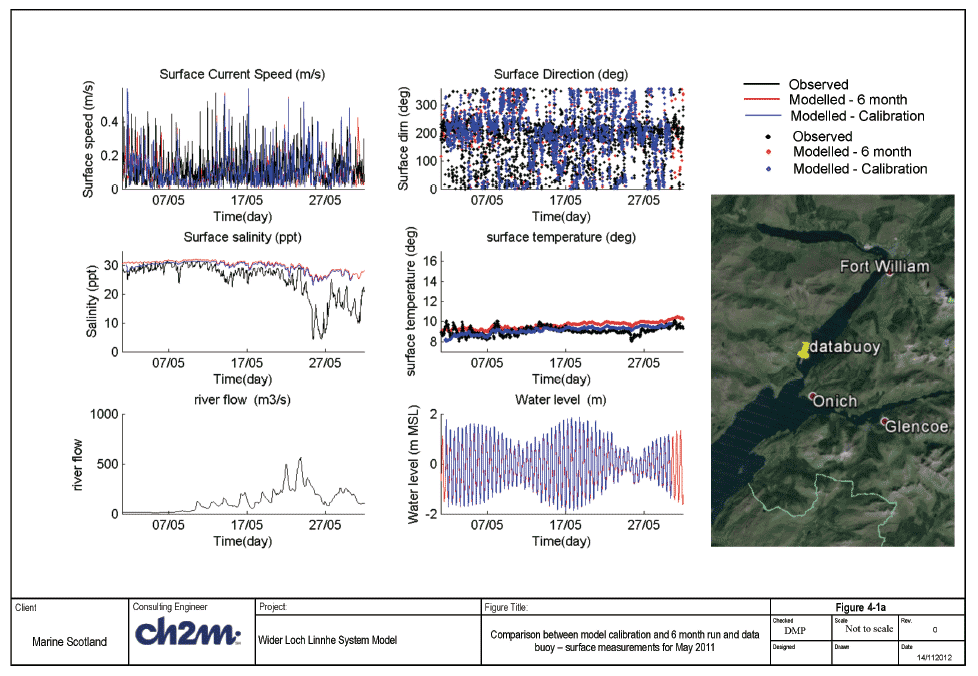
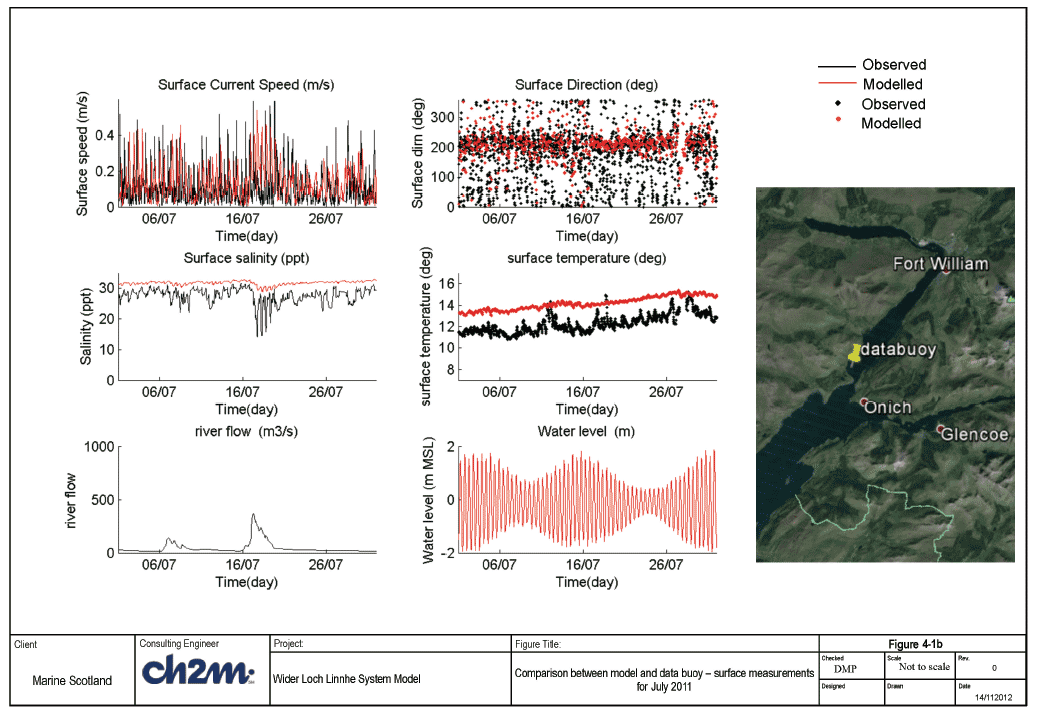
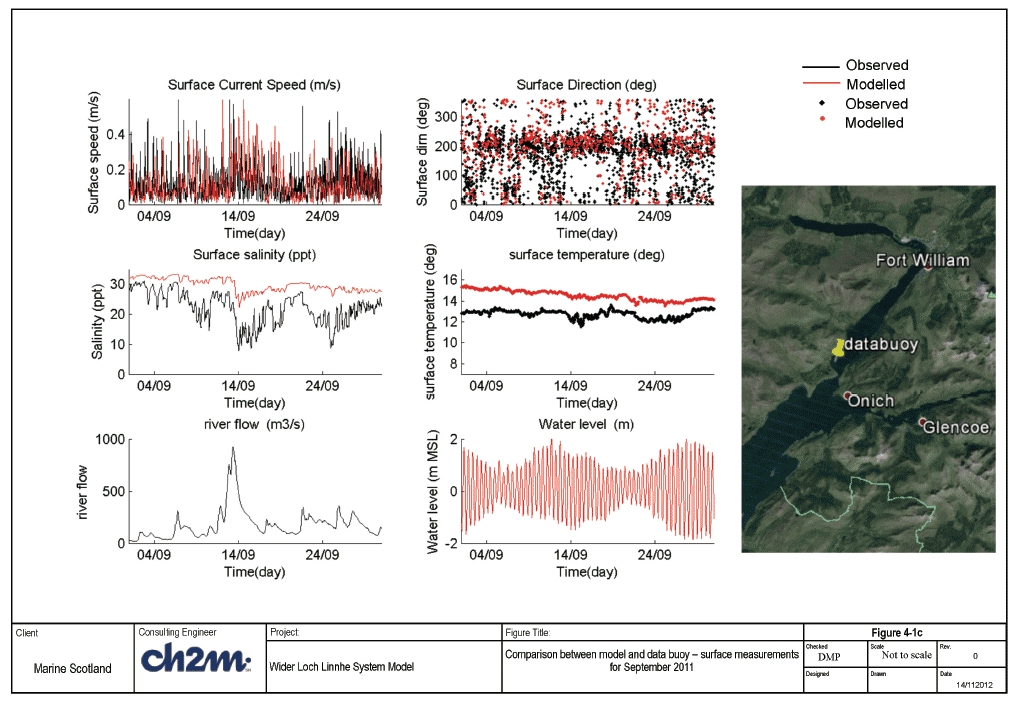
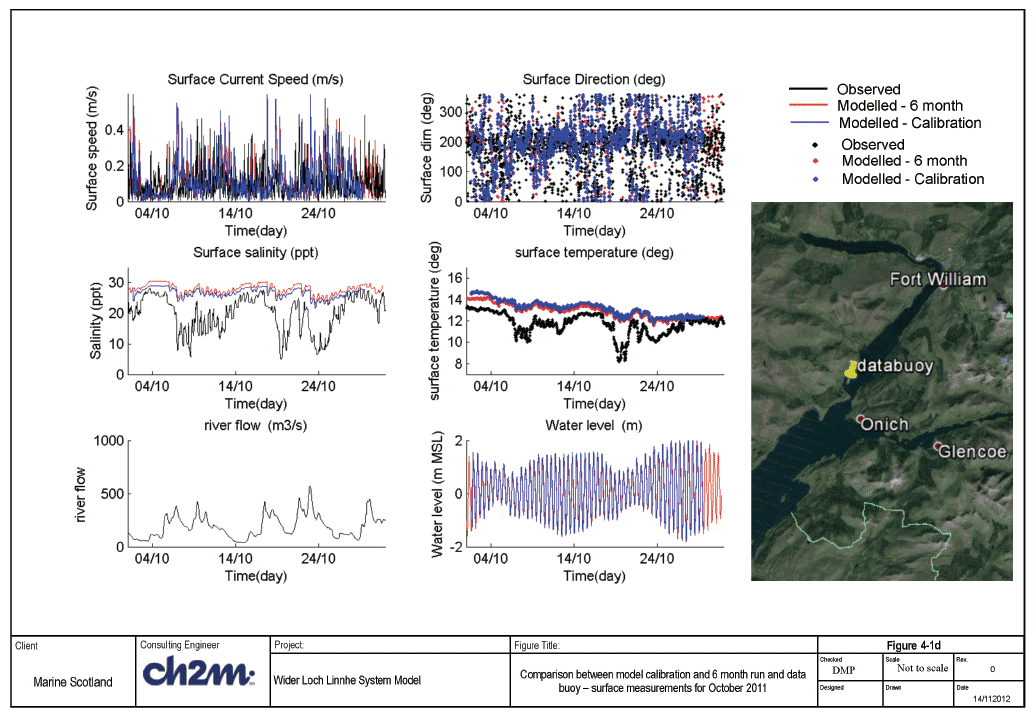
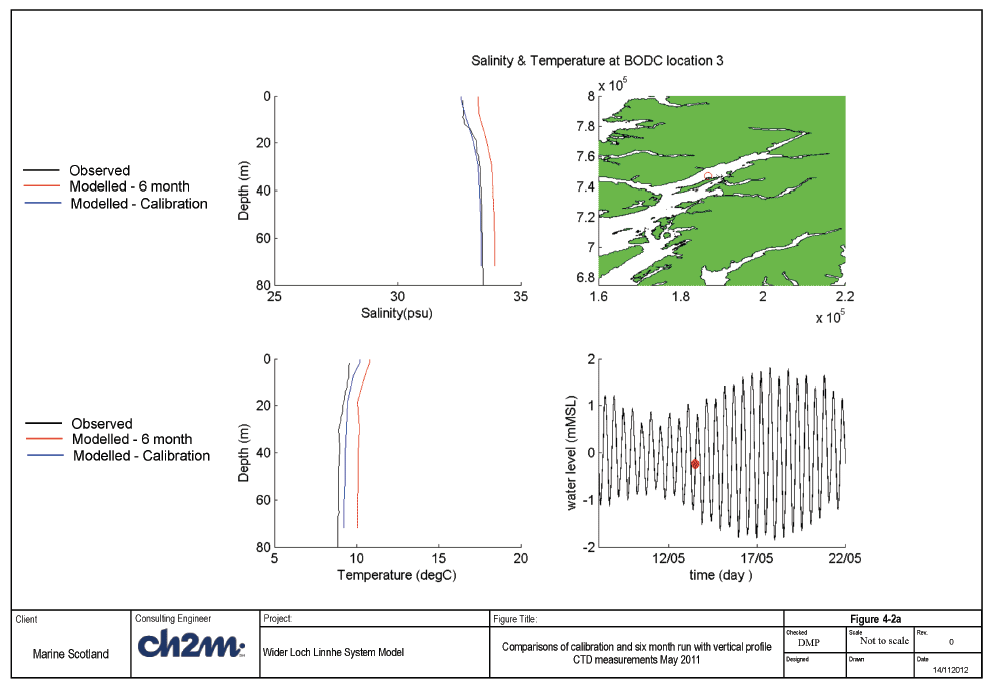
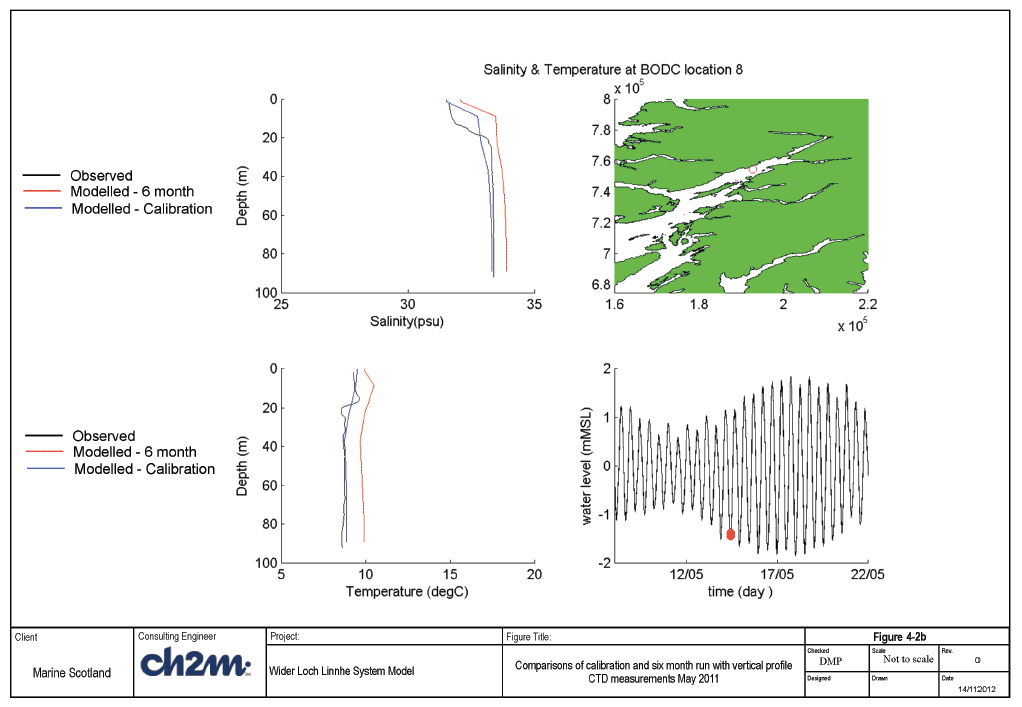
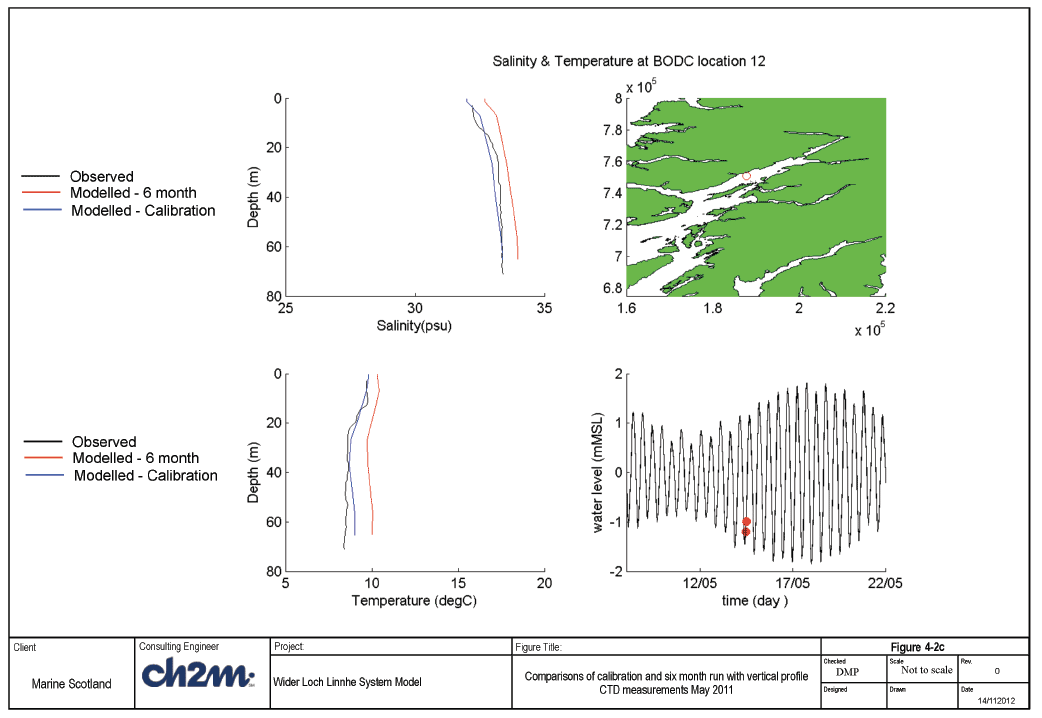
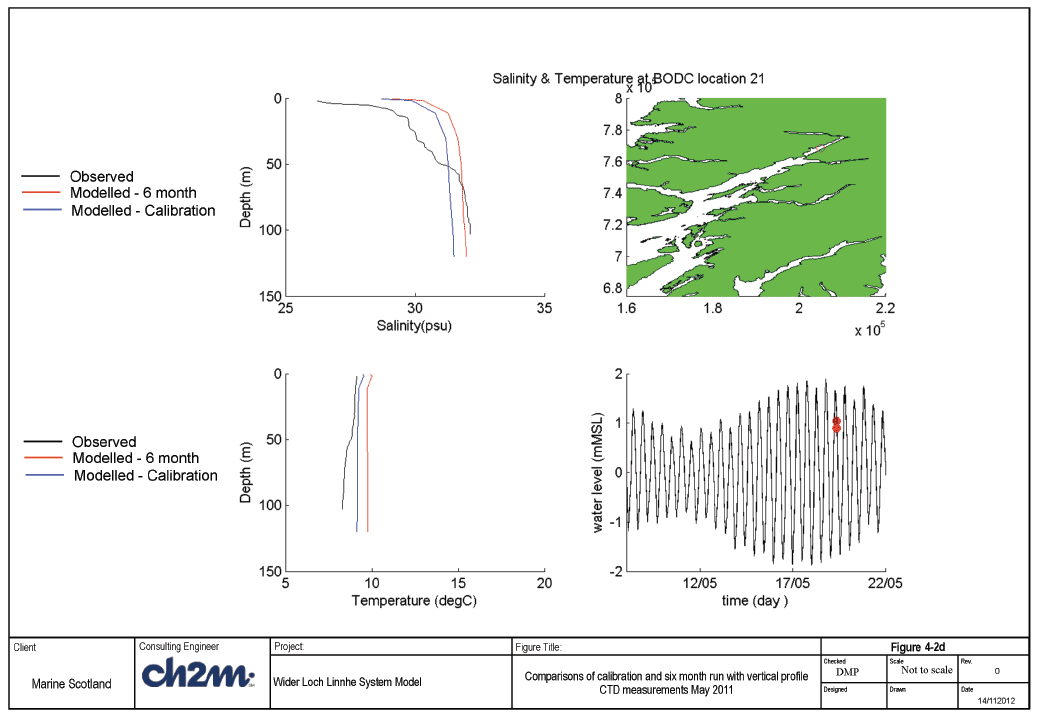
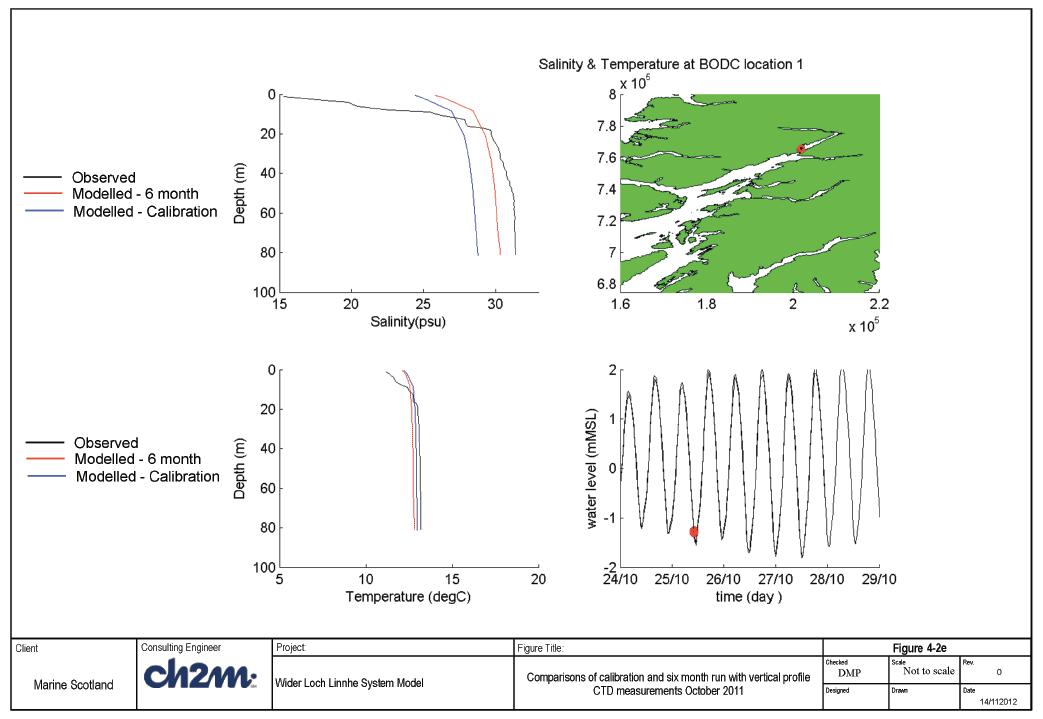
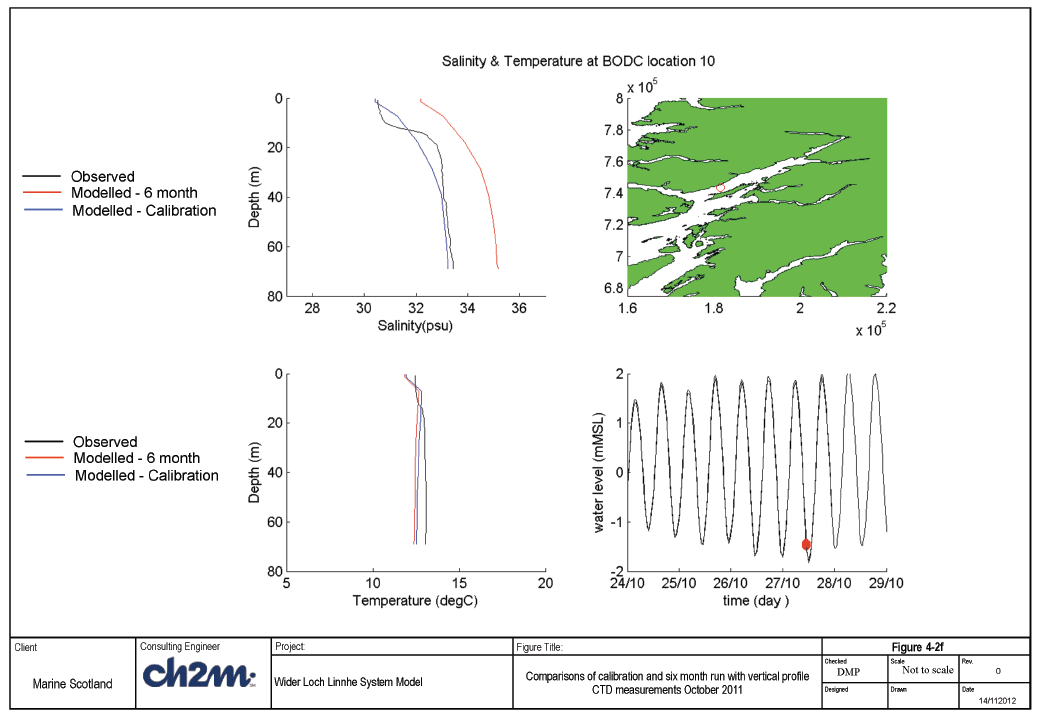
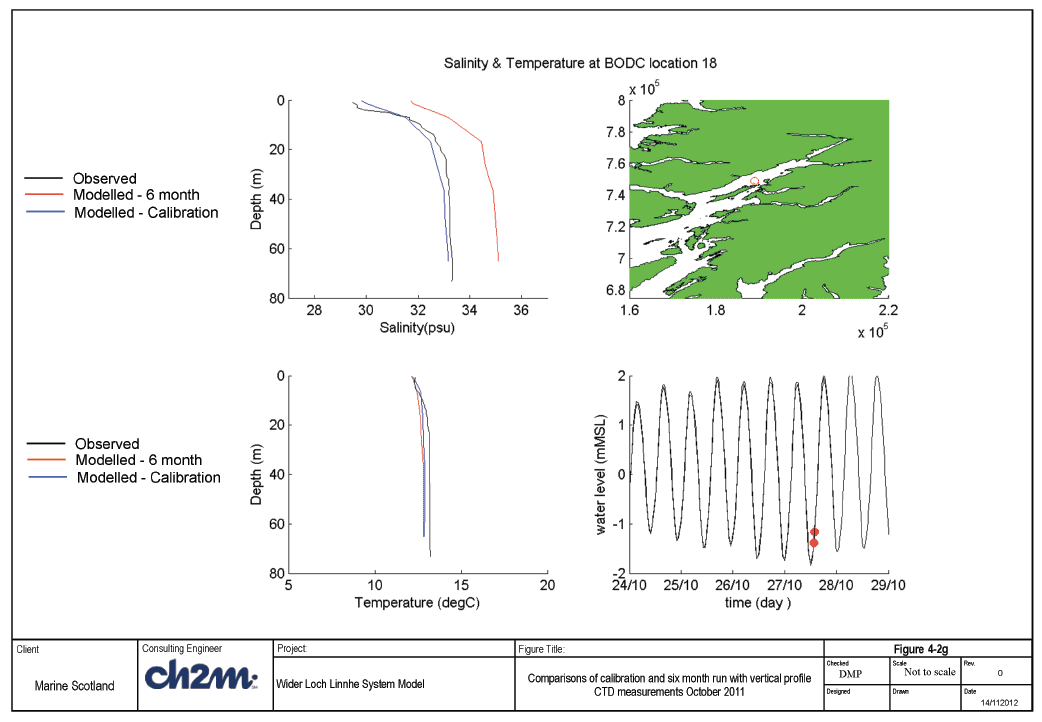
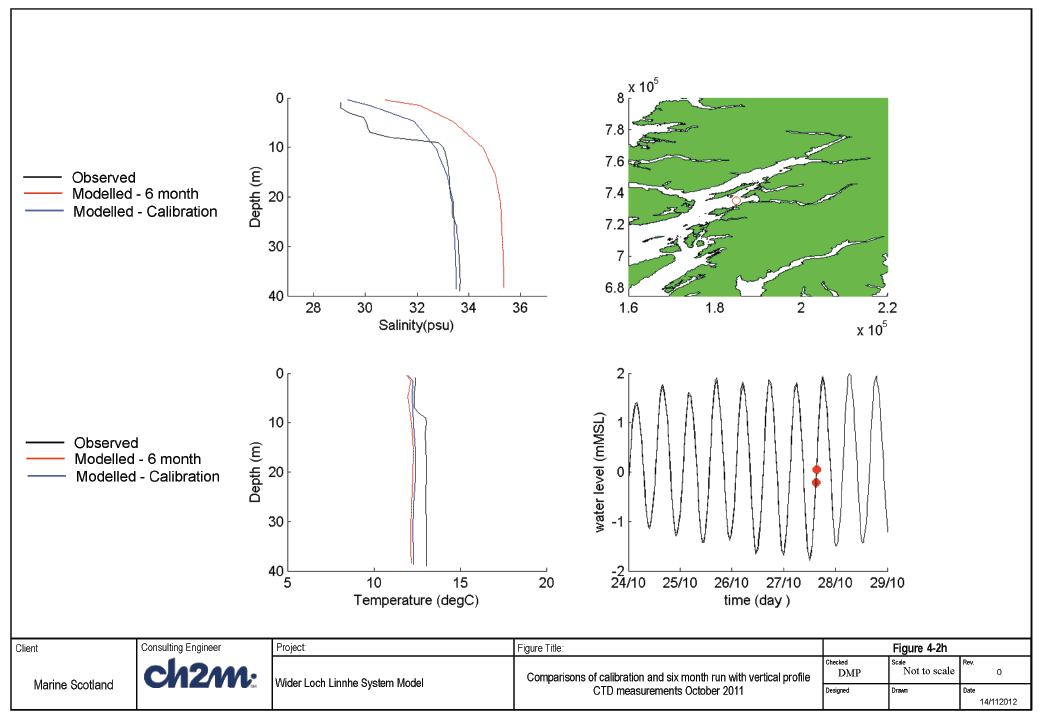
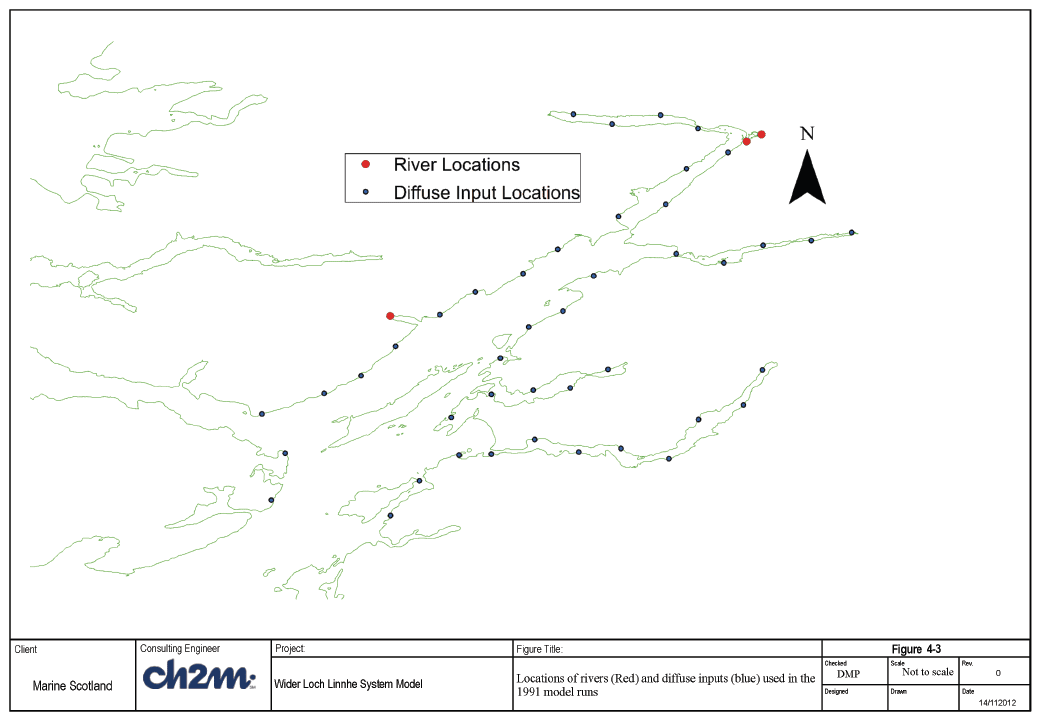
4.2 1991 Simulations
4.2.1 Input Data
The data sources for 1991 vary from those used in 2011. The water level, current, temperature and salinity data came from the POLCOMS 12km model provided by NOC-L. No met data was available from the AMM model so all parameters apart from wind data (wind speed and directions) were taken from the ECMWF interim datasets, i.e. shortwave and long wave downwards solar radiation, precipitation and evaporation (accumulated totals at 12 hourly time steps) and air temperature, sea level pressure (instantaneous at 6 hourly time steps). Relative humidity was calculated from air temperature and dew-point temperature. Wind data was available from the met office model at hourly intervals on a 50km grid. The data set was not complete and gaps were filled using the ECMWF interim dataset interpolated to hourly time steps from 6 hourly data. The wind file was put through the Matlab script developed in the calibration runs to take into account the topographic steering of the wind in Loch Linnhe. Finally the G2G river data was not available for 1991, instead data was provided by Marine Scotland for three rivers in Upper Loch Linnhe, River Nevis, River Lochy and Loch A'Choire. Diffuse inputs from the other catchments not included in the rivers was also provided and input into the model as a number of point source inputs as shown in Figure 4-3. River temperature derived from measured air temperature at Oban was also available from Marine Scotland, temperatures were applied to the rivers using a 7 day moving average of the data.
4.2.2 Results
An extensive field measurement campaign was carried out by Marine Scotland in Loch Linnhe during 1991. The data has been provided for comparison with model results, the comparisons are presented below.
4.2.2.1 Water Levels
Tide gauge data from BODC at Tobermory and pressure gauge data at two points in Loch Linnhe from Marine Scotland are available. The depth of the pressure gauges within the files from Marine Scotland are not correct, following discussion it was thought that due to the steep slope on which these recorders were deployed the depth of the sounding may not match the depth of deployment. Therefore the MS data has been manually adjusted to match the modelled water levels. Figure 4-4a shows the location of the measurements while Figure 4-4b-g shows the water level comparison at those locations for May and October. The RMS error and bias at Tobermory for the 6 month simulation was as 0.24m and 0.16m respectively.
4.2.2.2 Currents
Current measurements are available at three locations (Figure 4-5a) and a range of depths. The current speed and direction comparisons at location 1 during October, location 2 during July and location 4 during September are shown in Figure 4-5b-d respectively. At all locations the modelled current speeds are the same order of magnitude as the measured data. At times the size and shape of the peaks in current speed and the changes in flow directions are well replicated in the modelled data at location 1 and 2, particularly the mid and deep water comparisons. At MS current data location 4 in upper Loch Linnhe, where complex mixing occurs the comparison is not as strong, however the order of magnitude is the same.
4.2.2.3 Temperature and Salinity
Two thermistor chains were deployed by Marine Scotland one in the upper loch at and one in the lower loch (Figure 4-6a). Figure 4-6b and c show the temperature comparison at 1m, 31m and 61m at thermistor location 1 and 2 respectively for the entire model run. From May to September the model temperature is slightly higher than that measured at both locations and at all levels. This difference in temperature is more pronounced at MS thermistor location 2, located in the Upper Loch. From May to September the temperature of the model and the measurements increases, the model temperature increases at a slightly higher rate. From September the measured temperature either becomes constant or starts to decrease, at the same time the model temperature begins to decrease but, again, at a higher rate.
A number of CTD dips were also made during 1991, comparisons of a selection of the CTD dips from three zones (Figure 4-7a), are presented in Figure 4-7b-j. the variations in temperature seen in the thermistor data are replicated in the CTD data, with the temperature of the model being higher in May (approximately 1°C) and that temperature difference increasing towards September (approximately 2°C), then dropping to levels lower than the measured in October (approximately 1.5°C).
The salinity comparisons are very good, less than 1psu, up to October even replicating some of the stratification seen in the measure data. In October the difference increased to around 2psu in some locations, this may be due to the increase in river input during this time.
4.2.3 Summary
Overall the 1991 model runs replicate the water levels, currents and salinity in the WLLS well. The temperature comparisons were not as good, with the model heating up and cooling down at a higher rate than seen in the measured data.
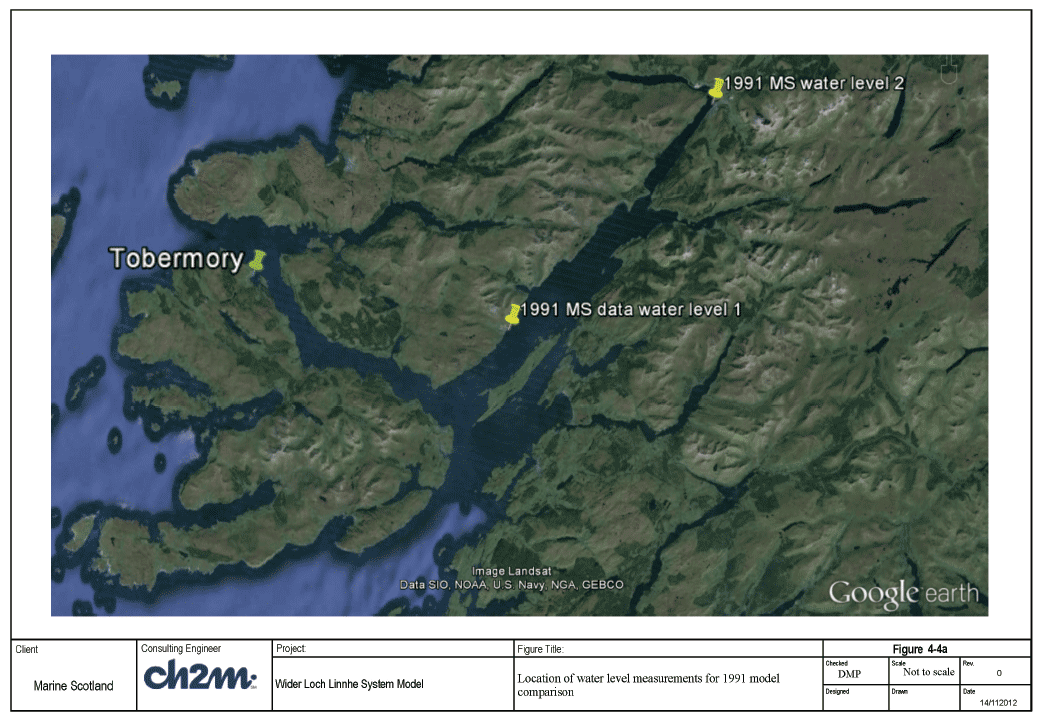
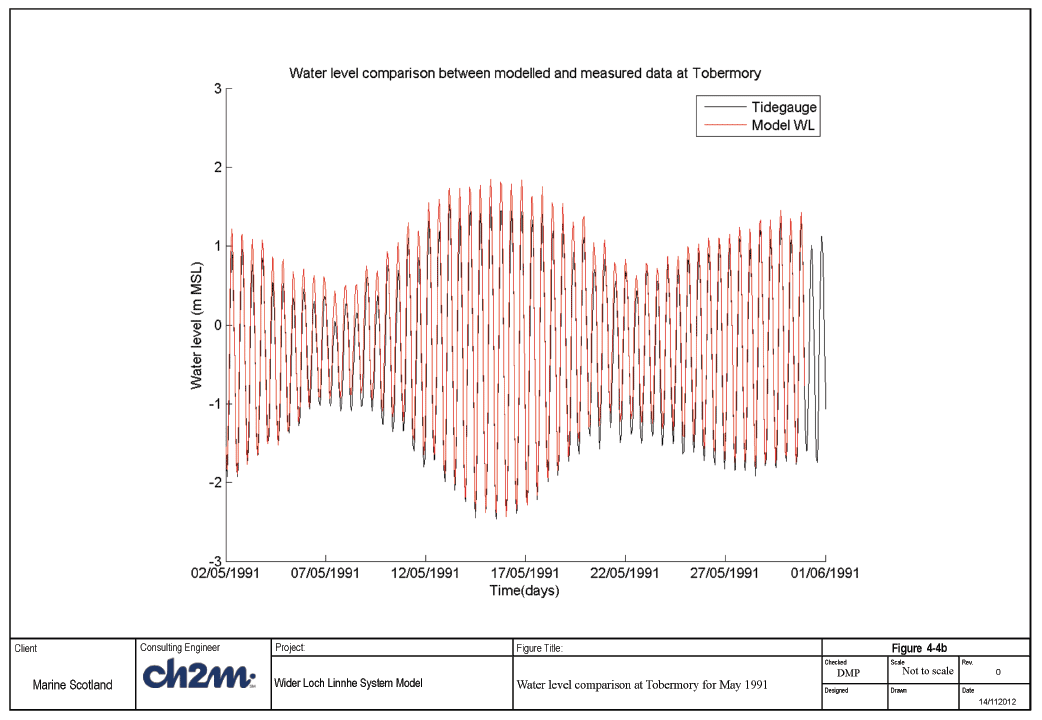
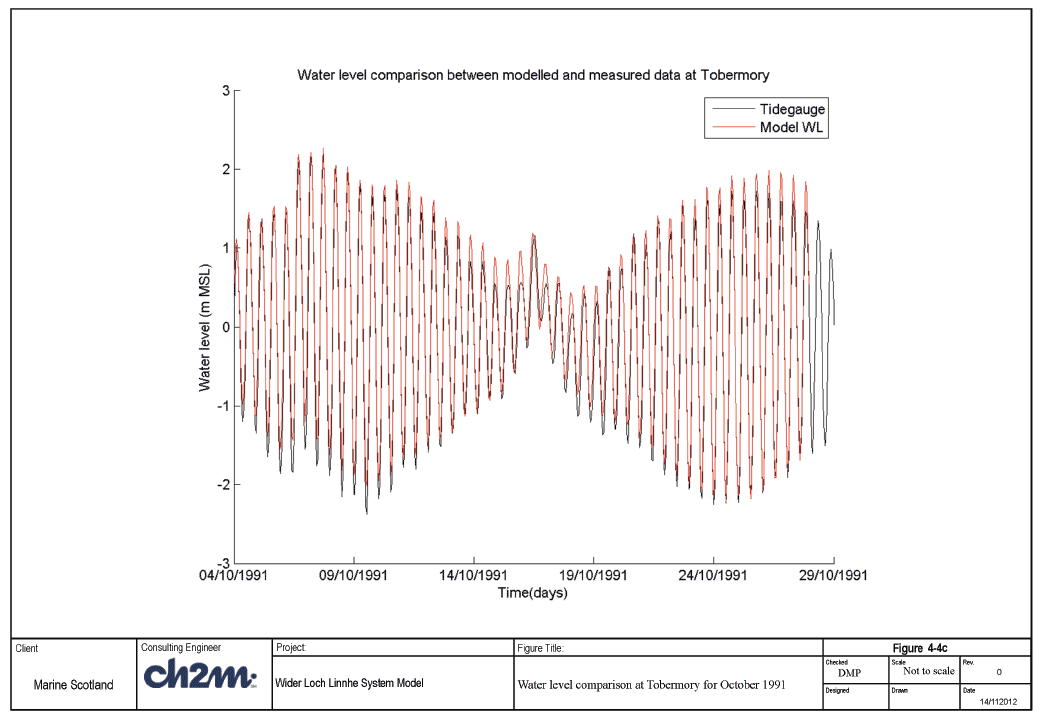
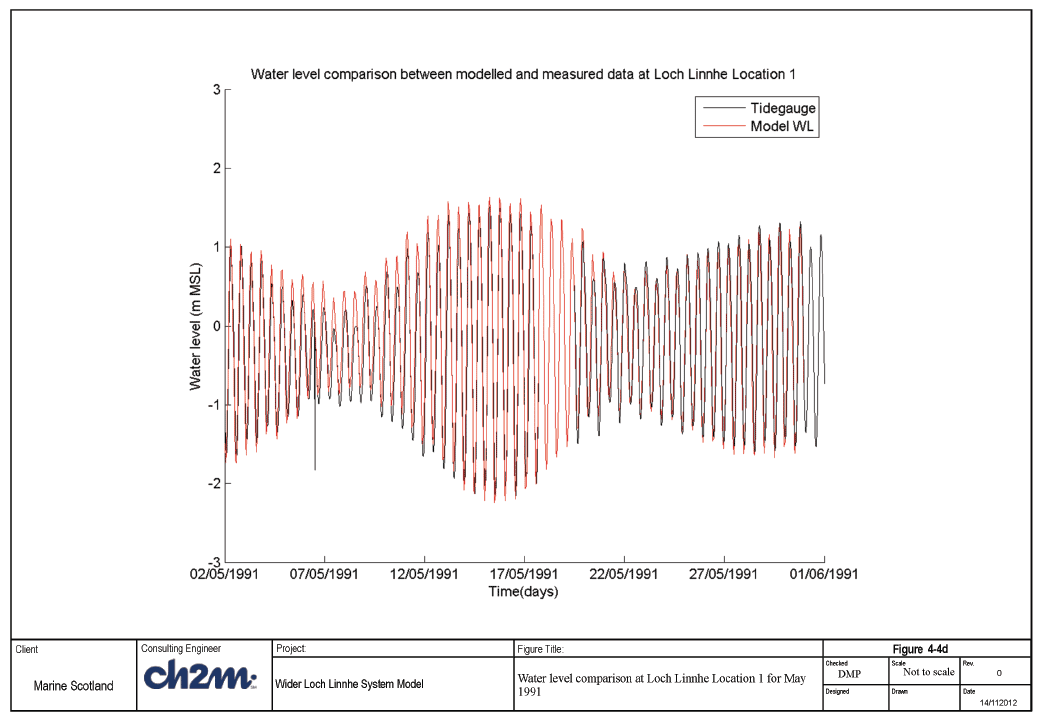
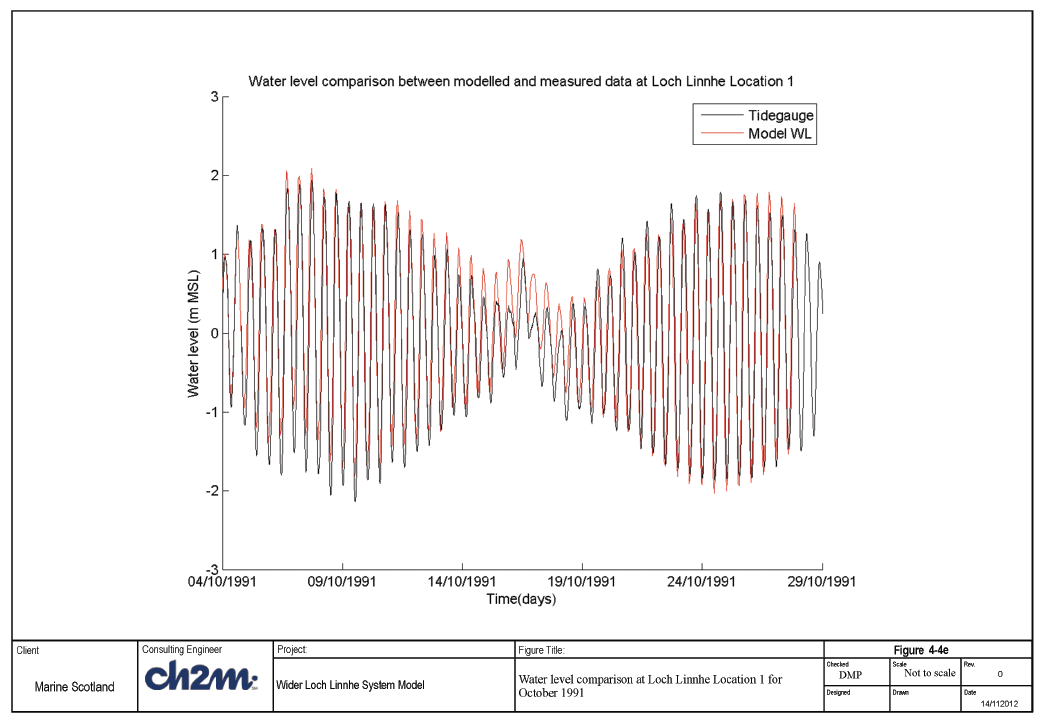
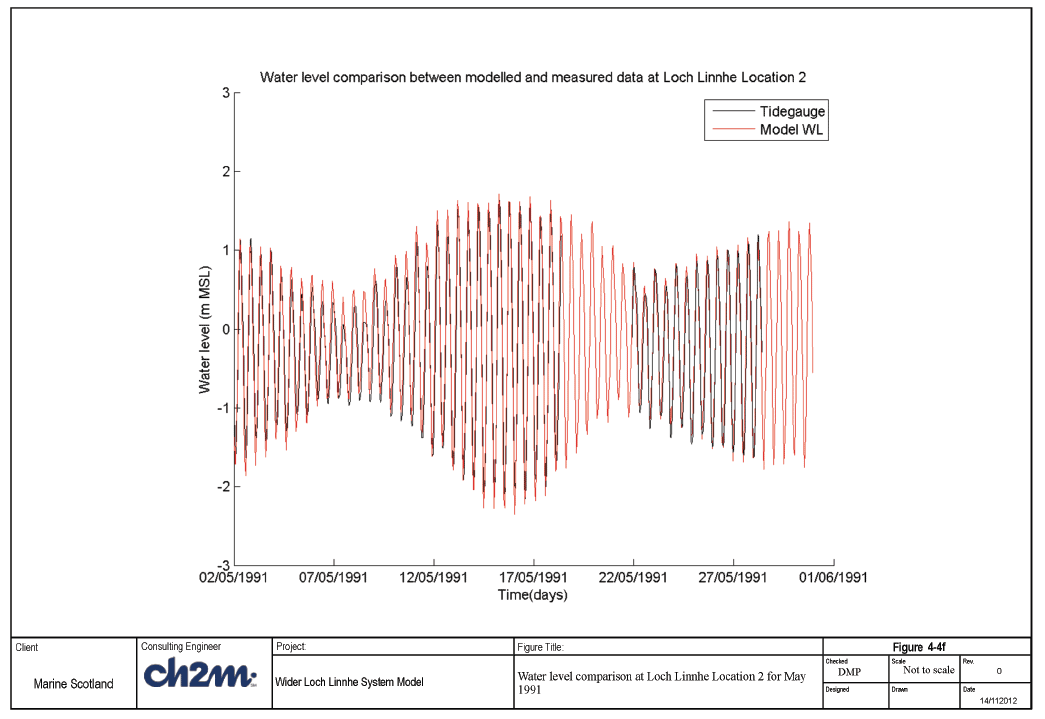
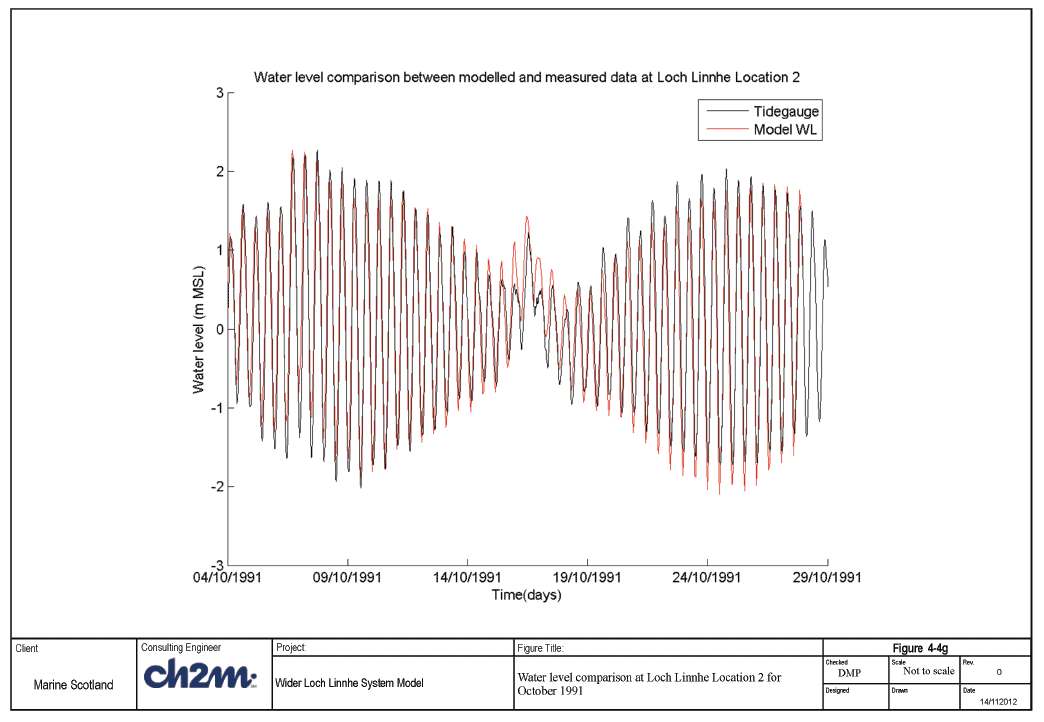
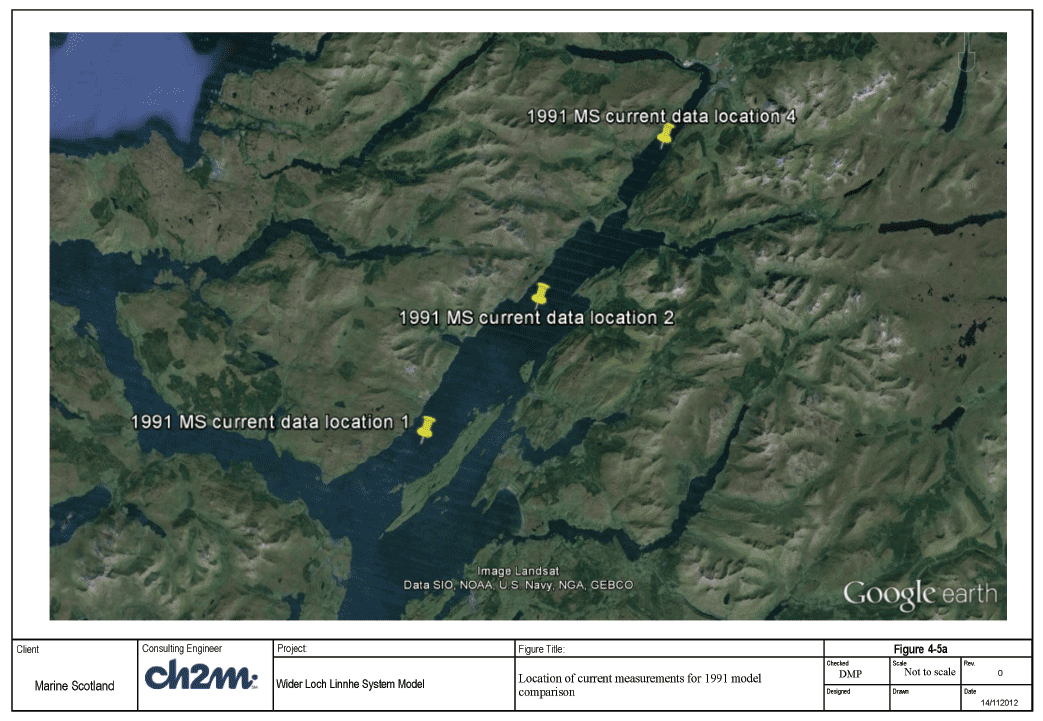
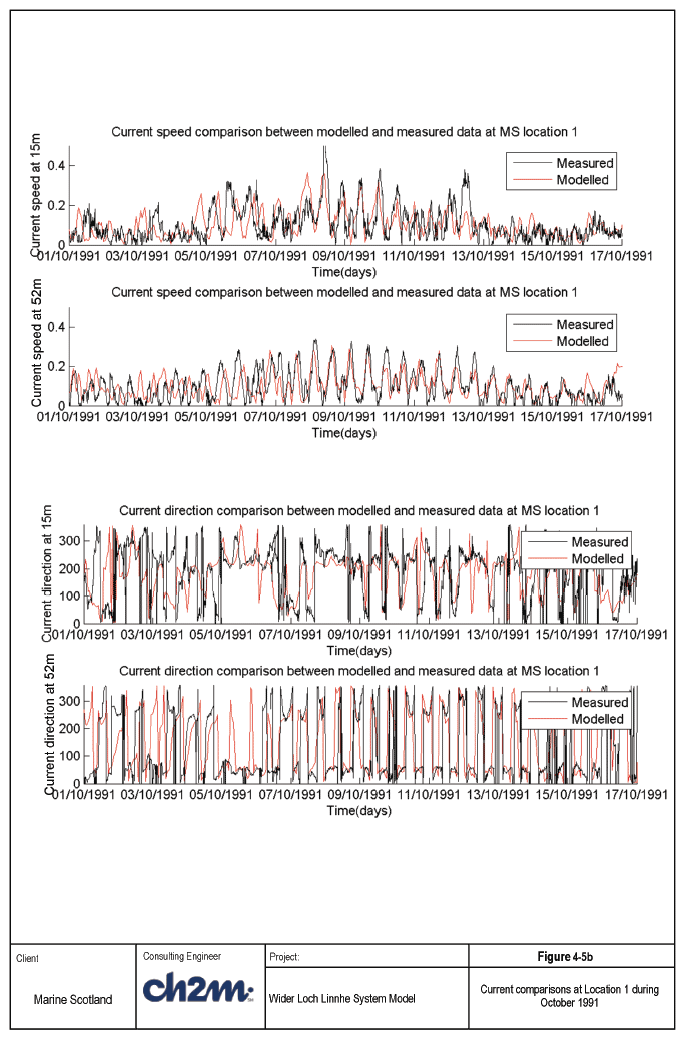
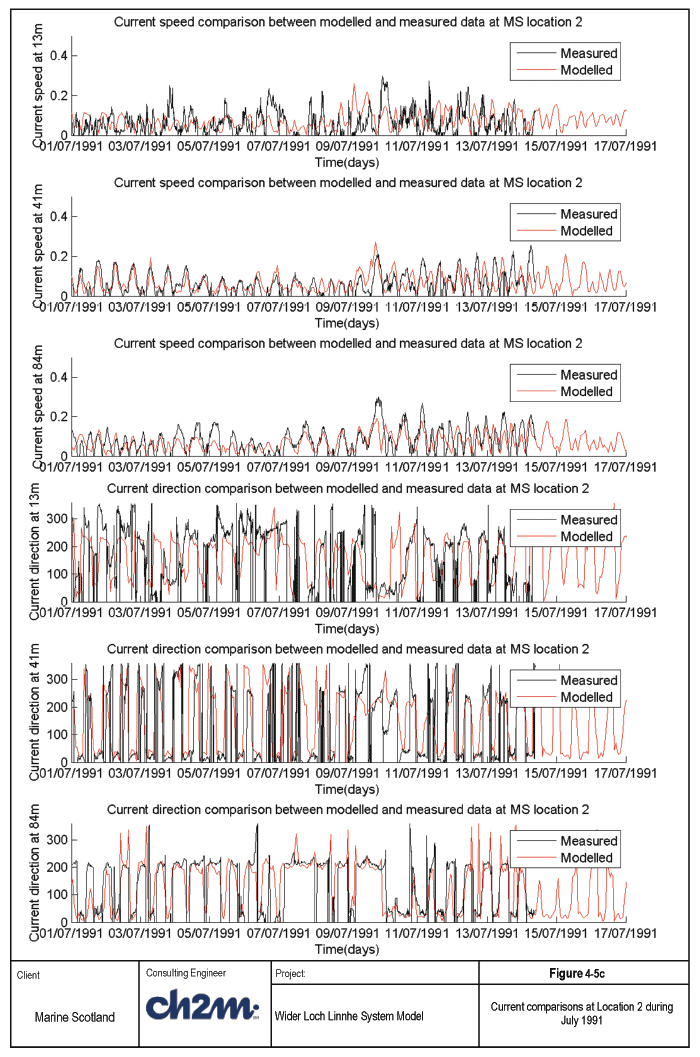
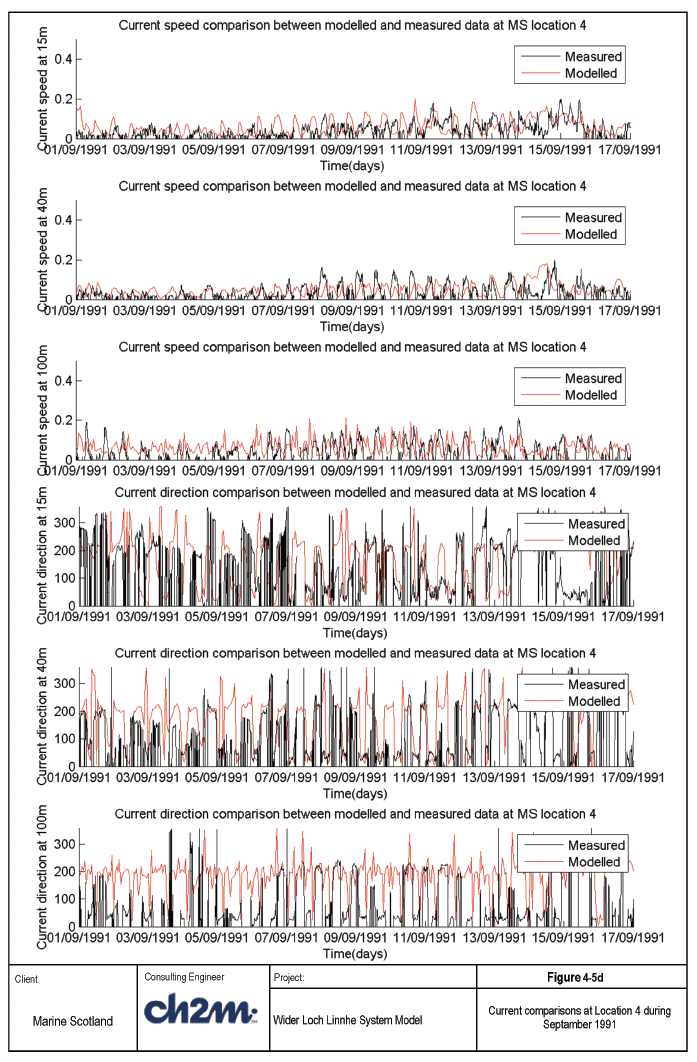
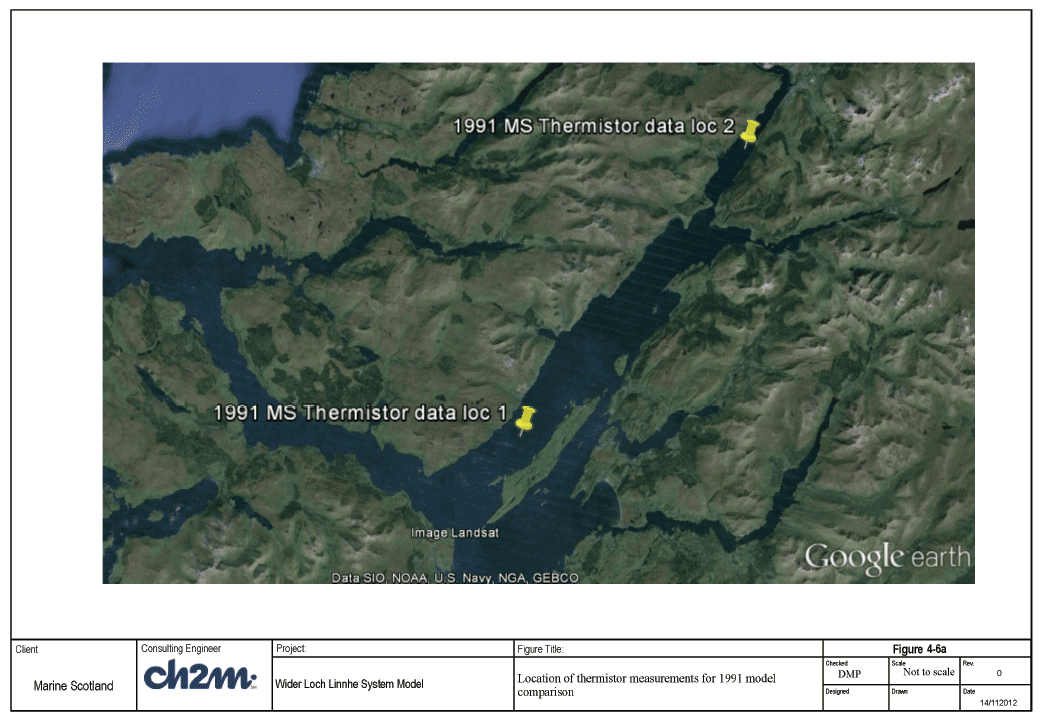
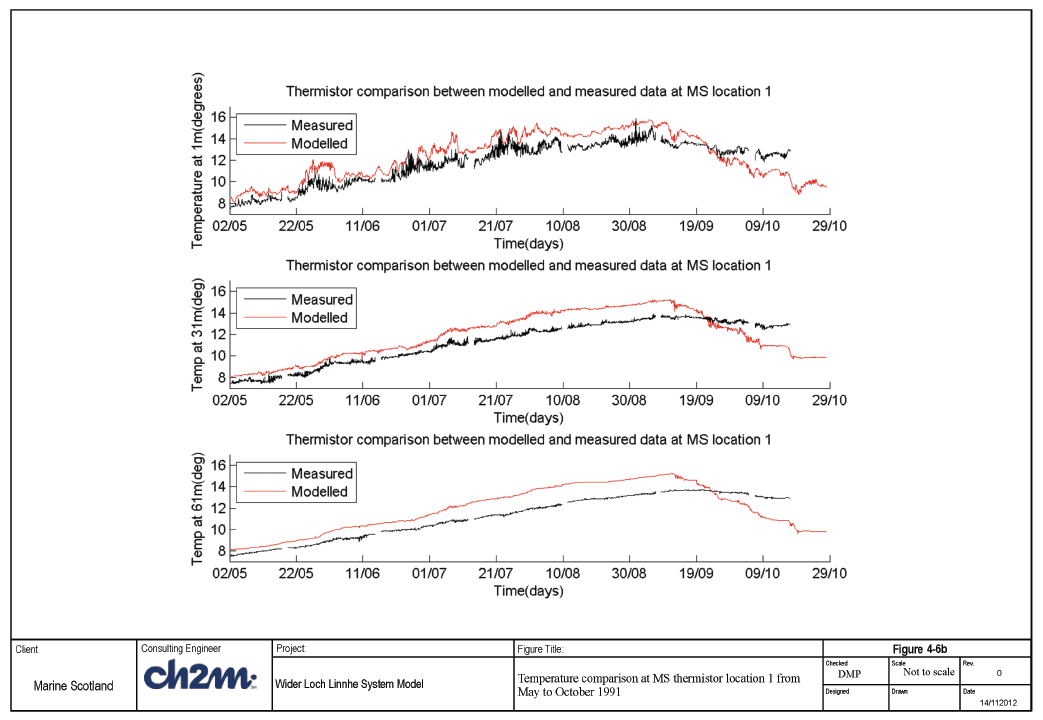
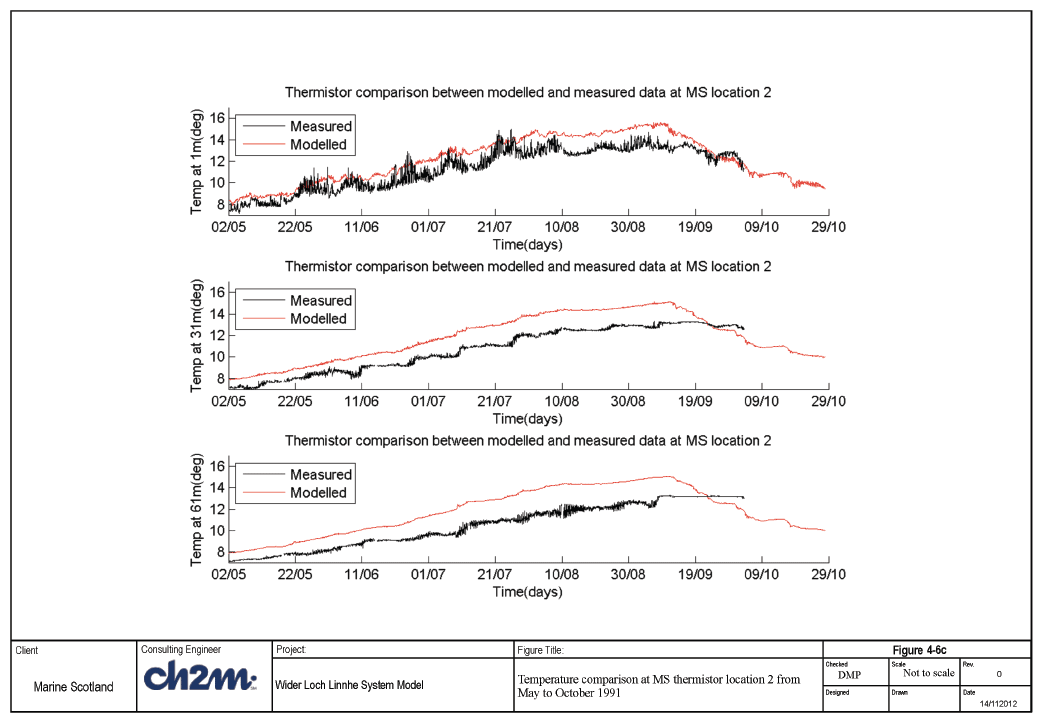
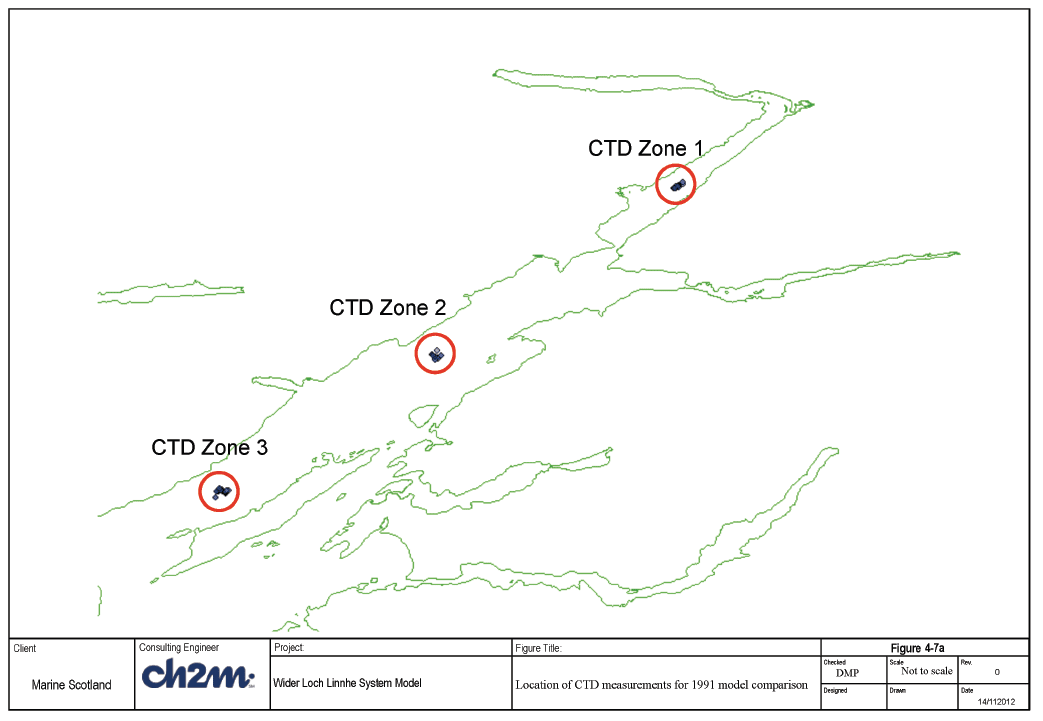
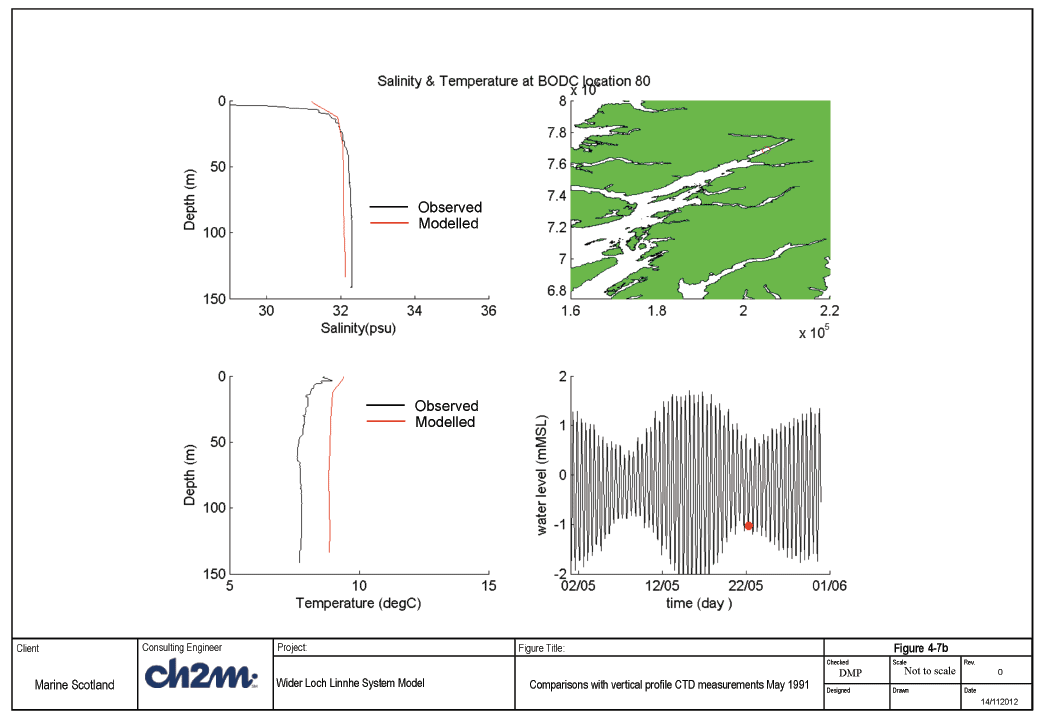
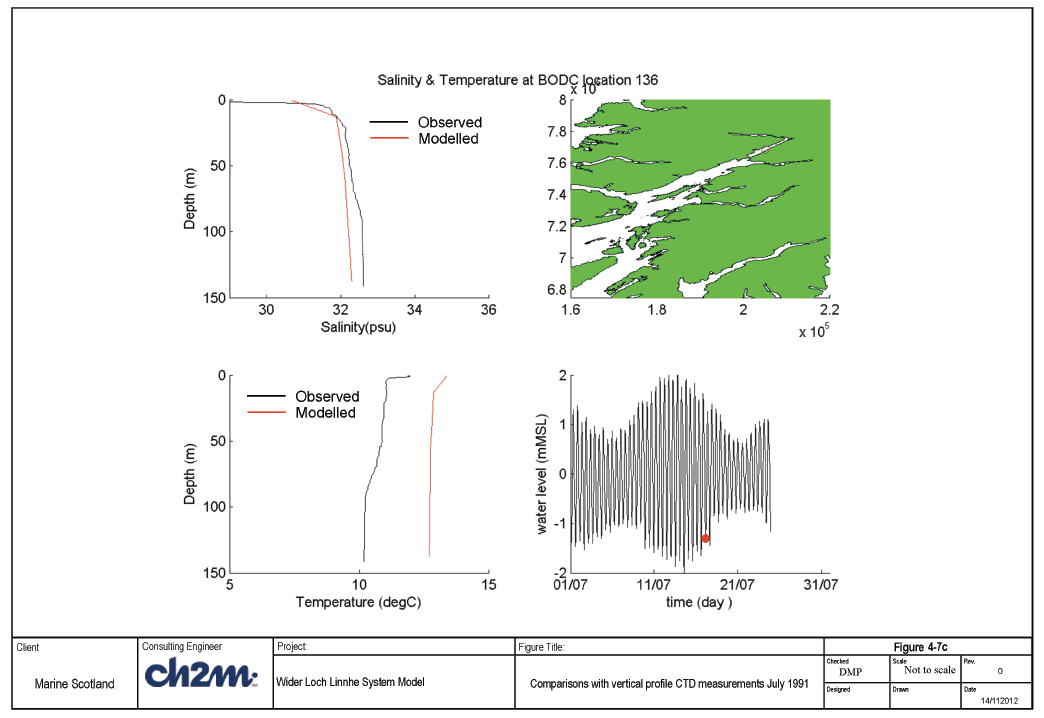
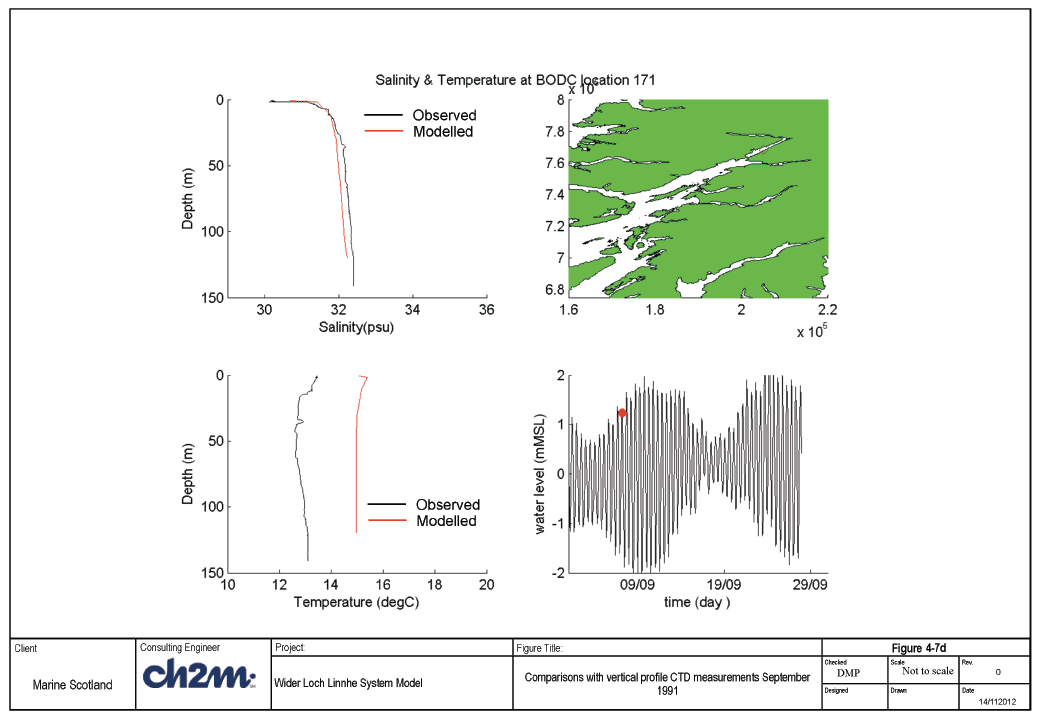
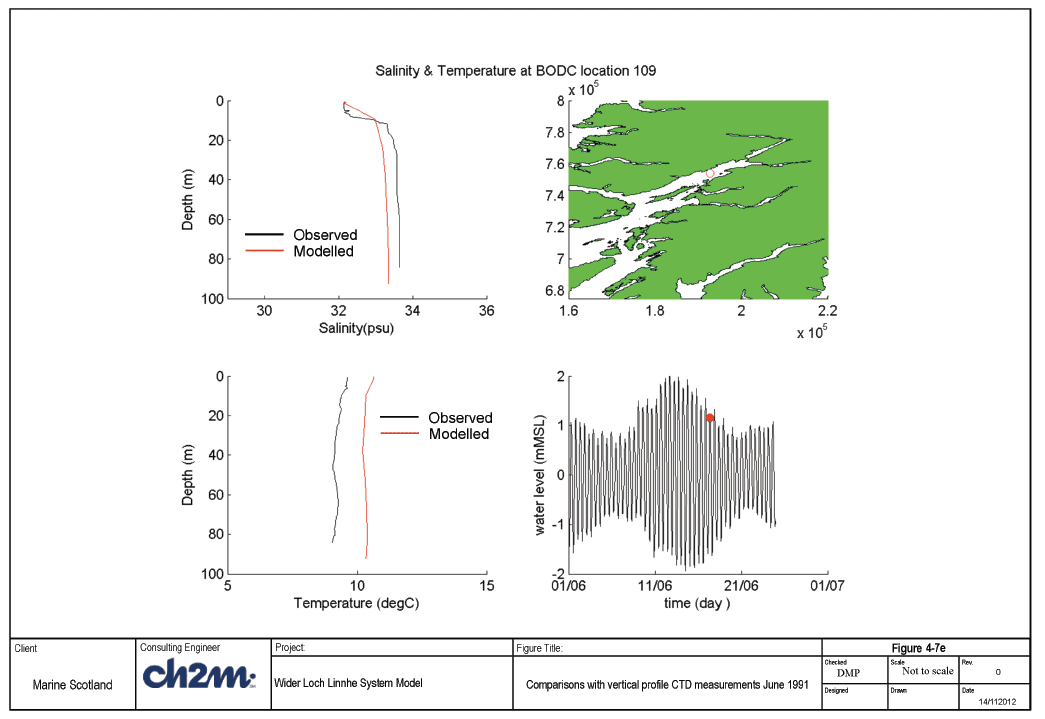
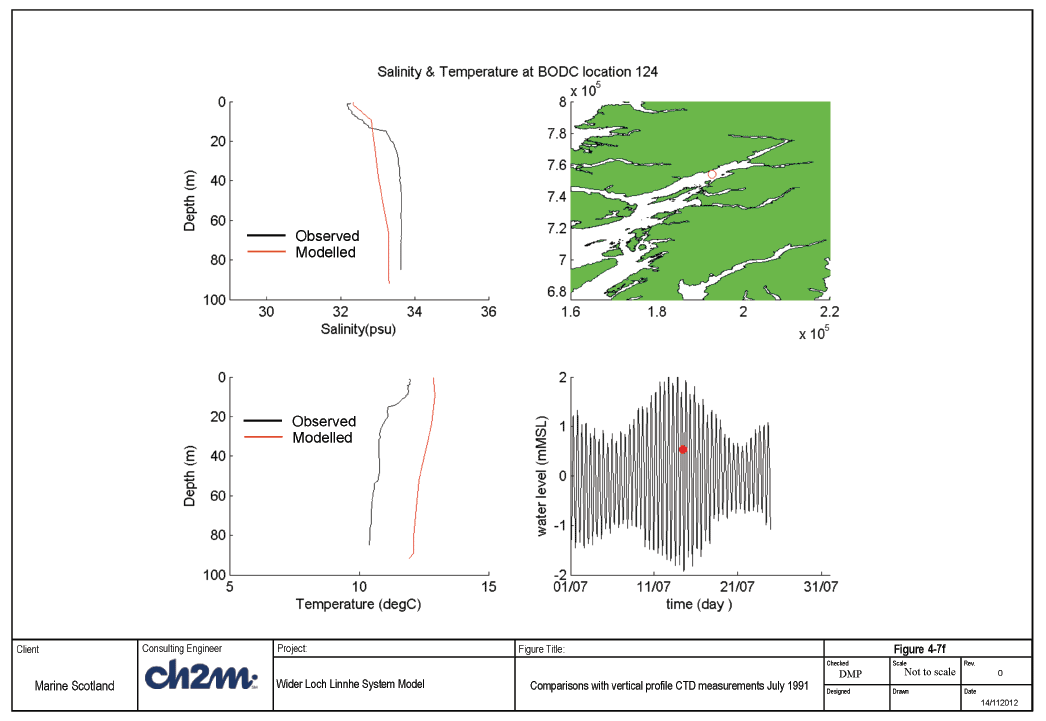
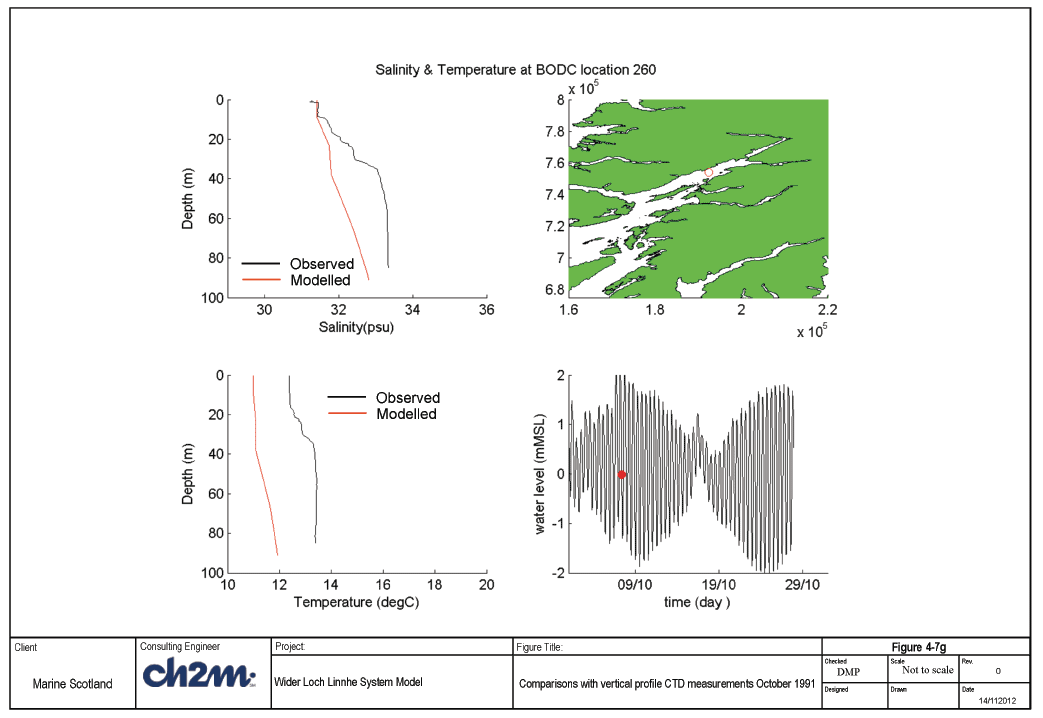
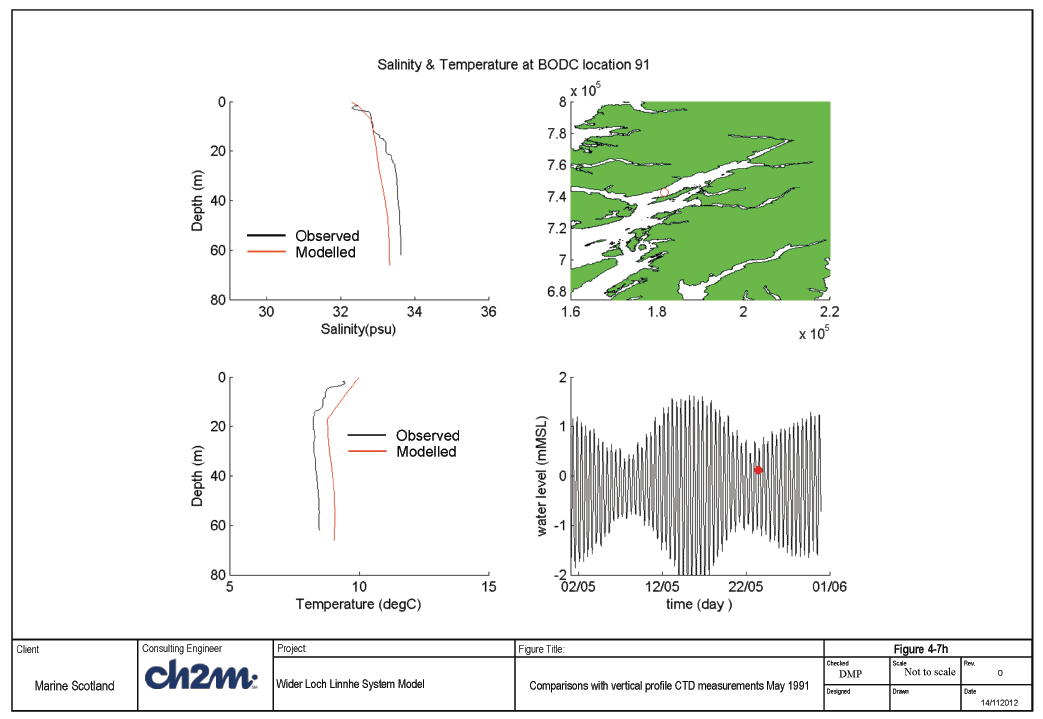
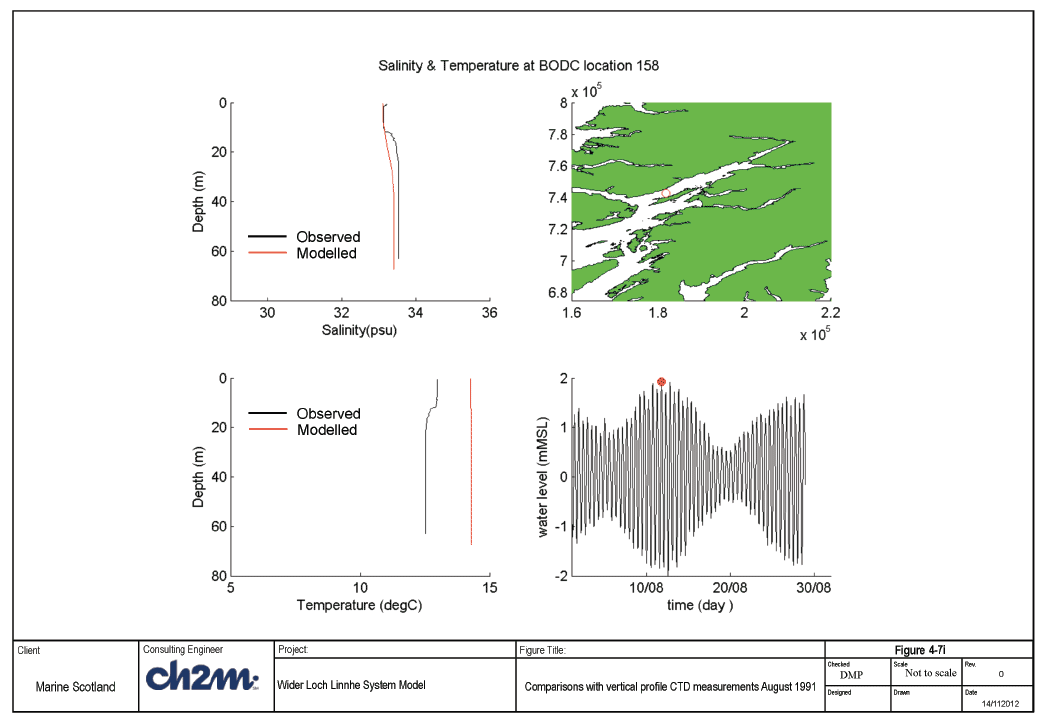
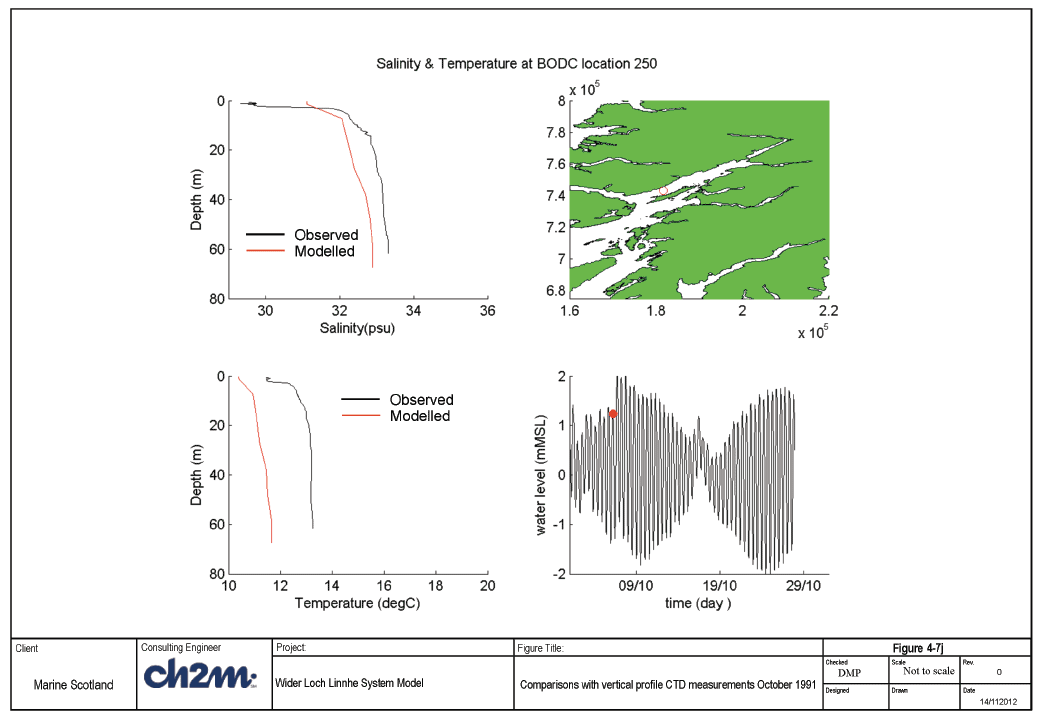
4.3 Climatology simulations
4.3.1 Introduction
This section of the report describes the climatology runs of the flow model for the Wider Loch Linnhe System ( WLLS). The model set up used has been described in the calibration section. The requirement was to produce a one year climatology run, from January to December, based on climatological forcing, representing a typical annual climate. The simulation was carried out using the Scottish Shelf model climatology results as initial conditions as well as for boundary conditions. The input data sets for climatological meteorological forcing and climatological river fluxes used in the Scottish Shelf model were also used for the WLLS model. For a full description of the input data, the sources and how it was processed for climatology runs see the Scottish Shelf Modelling report (Wolf et al. 2015)
The results from the climatology run will be used for particle tracking and to develop connectivity indices. The results have been compared with climatological atlas information for temperature, salinity and currents. The neap and spring tidal ranges and peak flows are also compared with the ABPmer tidal atlas.
4.3.2 Climatology Input Data
4.3.2.1 Boundary conditions
Boundary forcing for water levels (mean yearly tides), currents, temperature and salinity were taken from the Scottish Shelf model climatology results. Hourly results were interpolated on to the nested boundary nodes and elements using a Matlab script. Because the Scottish Shelf model was run with 20 layers whilst the WLLS model has been run with 10 variable layers it was also necessary to interpolate the current components, temperature and salinity from 20 even layers to 10 variable thickness layers. This was also carried out in the Matlab script.
4.3.2.2 River input
River climatology data was processed by NOC-L from two sources: (i) a reconstructed river climatology derived by reference to the E-HYPE model (126 Scottish rivers, 1980-2012 provided by the Swedish Meteorological and Hydrological Institute, SMHI), distributed across the 508 G2G river discharge locations for the Scottish mainland, as originally provided by CEH for March 2007 - Sep 2010 (see below) (ii) G2G river climatology (1962-2011, 577 rivers) provided by CEH in August 2014 and updated in October 2014. For full details of how the river data was reconstructed to give climatological daily averages, see the Scottish Shelf Modelling Report (Wolf et al. 2015). Only 151 of these rivers fall within the WLLS model domain. The rivers were processed in the same way as those for the baroclinic calibration model runs. Figure 4-8 shows the location of the rivers and the location of the nodes the rivers were applied at.
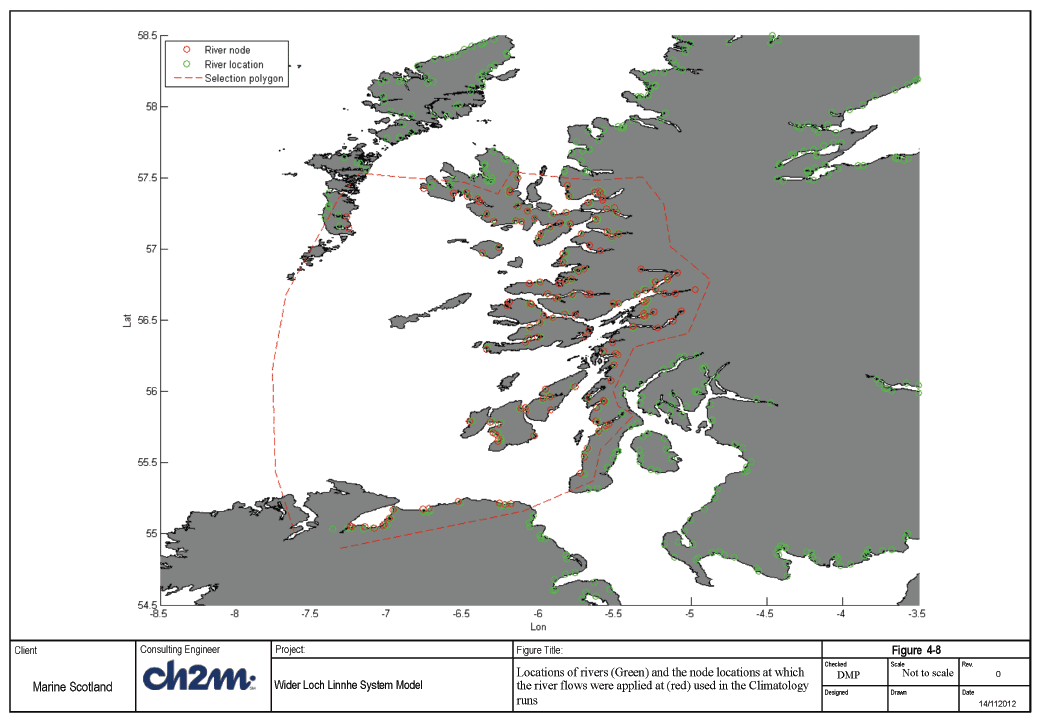
4.3.2.3 Meteorological forcing
Met forcing data for the climatology simulations were interpolated on to the WLLS mesh from the Scottish Shelf model met forcing input files at 6 hourly intervals. The met forcing was derived by the NOC-L from ECMWF ( ERA-40 and ERA-Interim, licence granted). The ERA-interim data cover 1989 - present, and ERA-40 data cover 1957 to 2002. These data were processed to derive monthly mean wind-stress, pressures, heating and "evaporation minus precipitation" for the period 1981-2010, to match the boundary forcing period.
The met forcing were derived as monthly means, which were specified at the middle of the month i.e. mean February data were applied at the middle of February; then mean March data were applied mid-March etc. The data are then linearly interpolated to 6-hourly smoothed forcing data for each grid-point in the FVCOM model. For full details see the Scottish Shelf Modelling report (Wolf et al. 2015).
4.3.3 Validation
4.3.3.1 Temperature and Salinity Comparisons
Average monthly sea surface temperature ( SST) and sea surface salinity ( SSS) observations are available from two sources:
1) The ICES (International Council of the Exploration of the Sea) dataset ( http://www.ices.dk/marine-data/data-portals/Pages/ocean.aspx) gridded and averaged for 1960-2004 (45 years) by Jason Holt ( NOC-L). Data are also available from the NOAA/ NDBC World Ocean Atlas (2013);
2) The WOA (World Ocean Atlas) http://www.nodc.noaa.gov/OC5/woa13/) based on over 100 years of observations interpolated on to a 0.25° resolution grid.
These datasets are used for qualitative comparison with the WLLS FVCOM results for February and August. These months were chosen based on the findings of Berx and Hughes (2009) that the maximum and minimum of the SST occur in February and August.
Figures 4-9a-b shows the comparison of SST for February and August respectively. The SST in the interior of the WLLS model is lower than both the validation data sets ( ICES and WOA) and the Scottish Shelf model, by around 2°C. The cause for this difference has been investigated and is thought to be due to a number of factors. Firstly the river temperature in the WLLS model was set to 7°C to be in line with the calibration runs, while the river temperatures in the Scottish Shelf model are set to 10 °C. Table 4-1 shows the quarterly mean river temperature for 15 rivers across Scotland, from Sparks et al., 2006. The annual mean is 9.4°C which is closer to the value used in the Scottish Shelf model, while the average for January to March is 7.2°C which is in line with the value used in the WLLS model. The other factor that may be influencing the temperature of the model is the difference in the spatial resolution of the model both in term of the horizontal mesh and vertical layers.
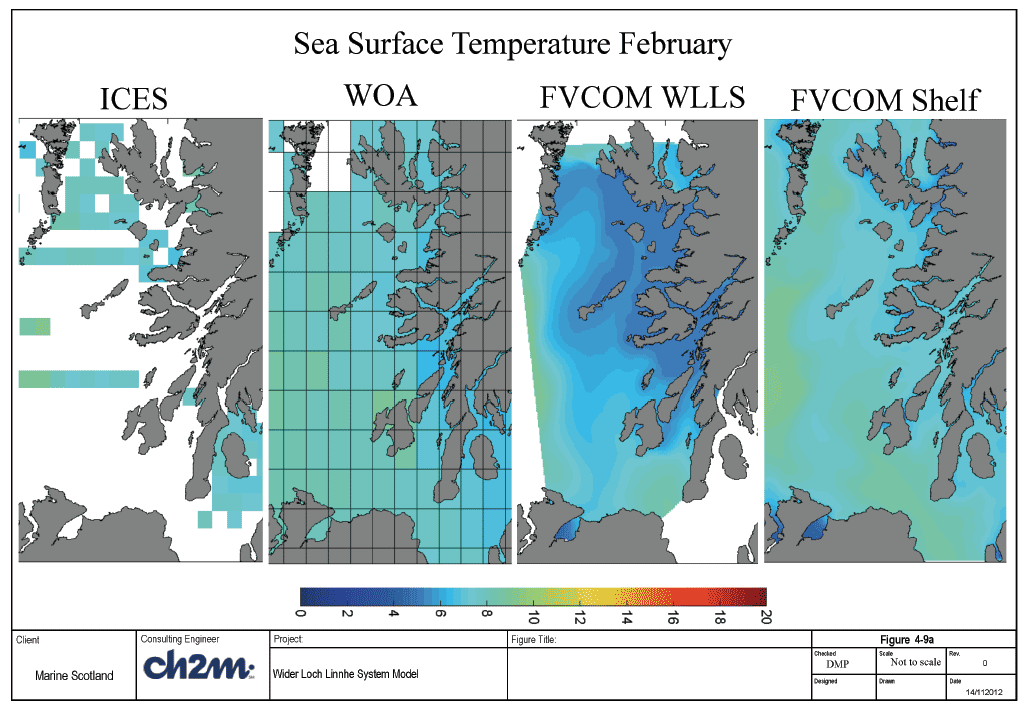
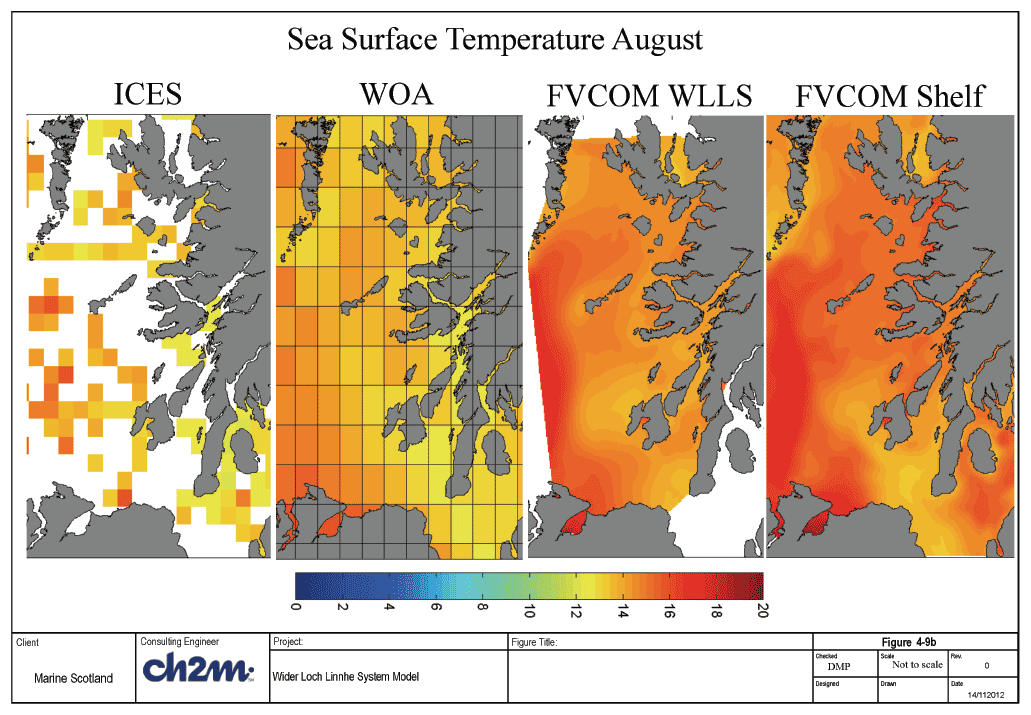
Table 4‑1: Quarterly mean river temperatures (°C) for 15 rivers across Scotland 1975-2003. From Sparks et al., 2006.
| Quarter | Mean river temperature (°C) |
|---|---|
| Jan/Feb/Mar | 7.2 |
| Apr/May/Jun | 14.8 |
| Jul/Aug/Sep | 11.1 |
| Oct/Nov/Dec | 4.3 |
| Annual mean | 9.4 |
The comparison of SST in August is better than February, the WLLS results are higher than those of the ICES and WOA but are closer to the Scottish Shelf results from which it took its boundary conditions and forcing data. This improvement in the comparison in August when river discharges are low supports the theory that the difference seen in February, when discharge is high, is related to the temperature difference in the rivers.
Figure 4-10a-b shows the SSS comparisons for February and August respectively. In both the WLLS model and Scottish Shelf model the influence of river discharge is seen close to land in February and August, with the area of low salinity surface water reducing from February to August. In February the FVCOM models show lower SSS levels that the WOA data across the model domain. In August the salinity in the FVCOM models is higher in the offshore areas. The ICES coverage in the WLLS area is poor.
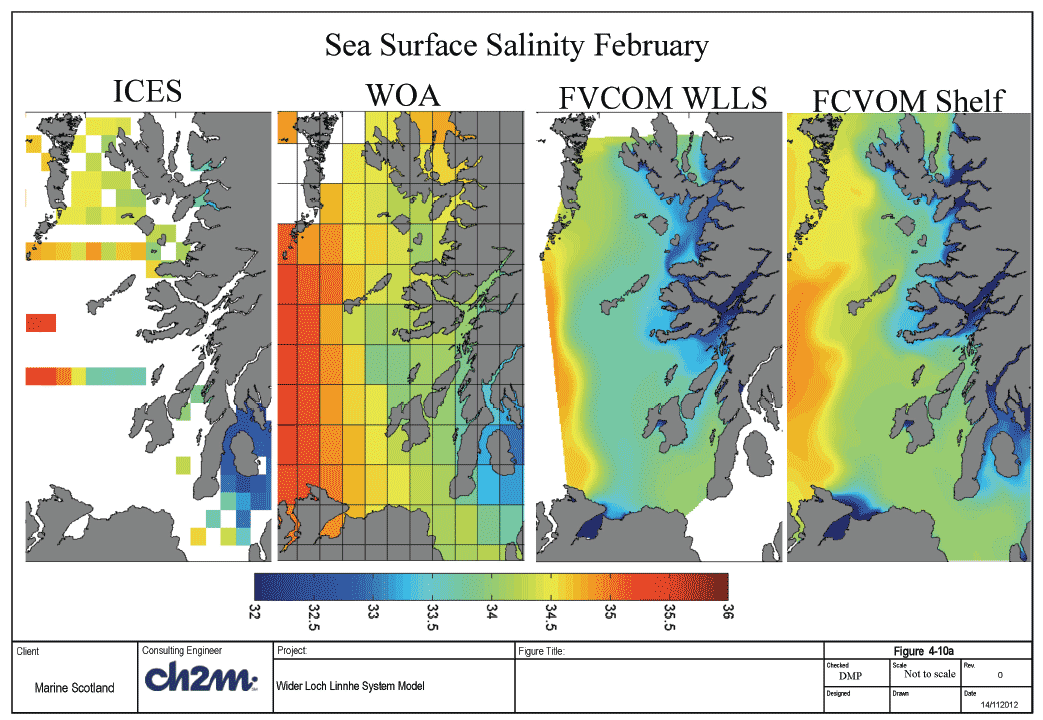
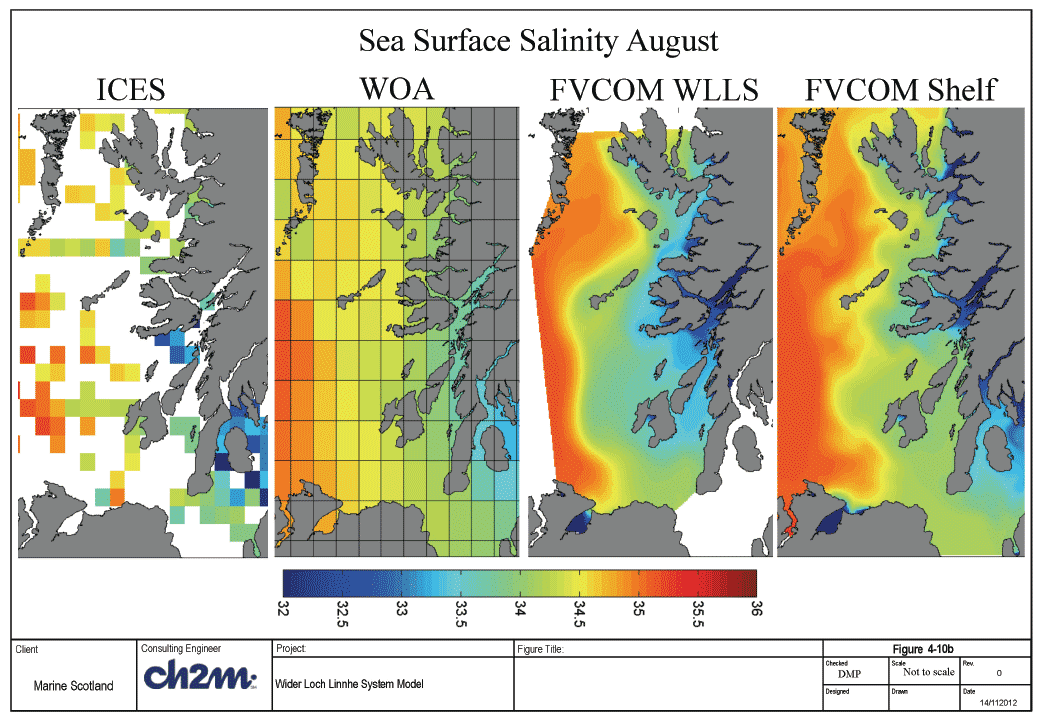
4.3.3.2 Mean Spring/Neap Tidal Range
Average monthly sea surface temperature ( SST) and sea surface salinity ( SSS) observations are available from two sources:
Mean spring tidal ranges have been computed directly from the two principal semi-diurnal components M 2 and S 2 based on the following equations from Pugh (1987):
mean high-water springs = Z 0 + (H M2 + H S2)
mean low-water springs = Z 0 - ( H M2 + H S2)
spring tidal range = mean high-water springs - mean low-water springs
Values for these constituents were obtained from a harmonic analysis of 60 days' worth of data from the WLLS climatology run (01/Jan - 01/March). These harmonic components control the timing of the spring-neap cycle, and their combination is considered to give a good measure of average spring (and neap) tides. The data was also used to calculate the mean neap tidal range as:
mean high-water neaps = Z 0 + (H M2 - H S2)
mean low-water neaps = Z 0 - (H M2 - H S2)
neap tidal range = mean high-water neaps - mean low-water neaps
A map of the mean spring results are shown, along with the equivalent tidal range from the ABPmer / NOC Atlas of Marine Energy Resources ( http://www.renewables-atlas.info/) in Figure 4-11a. The corresponding plots for mean neap tidal range are shown in Figure 4-11b. The magnitude of the spring tidal range in the WLLS FVCOM model shows good agreement with the ABPmer Atlas. There are some differences in the location of the contours, with the 4m contour further northeast in the FVCOM model and the area of less than 1m shifted to the east. This is likely to be related to the increased resolution of the FVCOM model. In the ABPmer model the islands of Skye, Mull and Jura are connected to the mainland. The neap tidal range comparison shows good agreement between the two models in both the magnitude and location of tidal range contours.
Further comparisons were made at a number of locations where the M2 and S2 constituents are available from the Admiralty tide tables (Figure 4-12a). Due to the lower resolution of the ABPmer model, comparison was not possible at a number of points. In general the FVCOM WLLS tidal range is greater than the Admiralty tidal ranges, both spring and neap (Figure 4-12b and Figure 4-12c respectively). In the locations with available ABPmer data the tidal ranges are the same or greater than the FVCOM WLLS ranges.
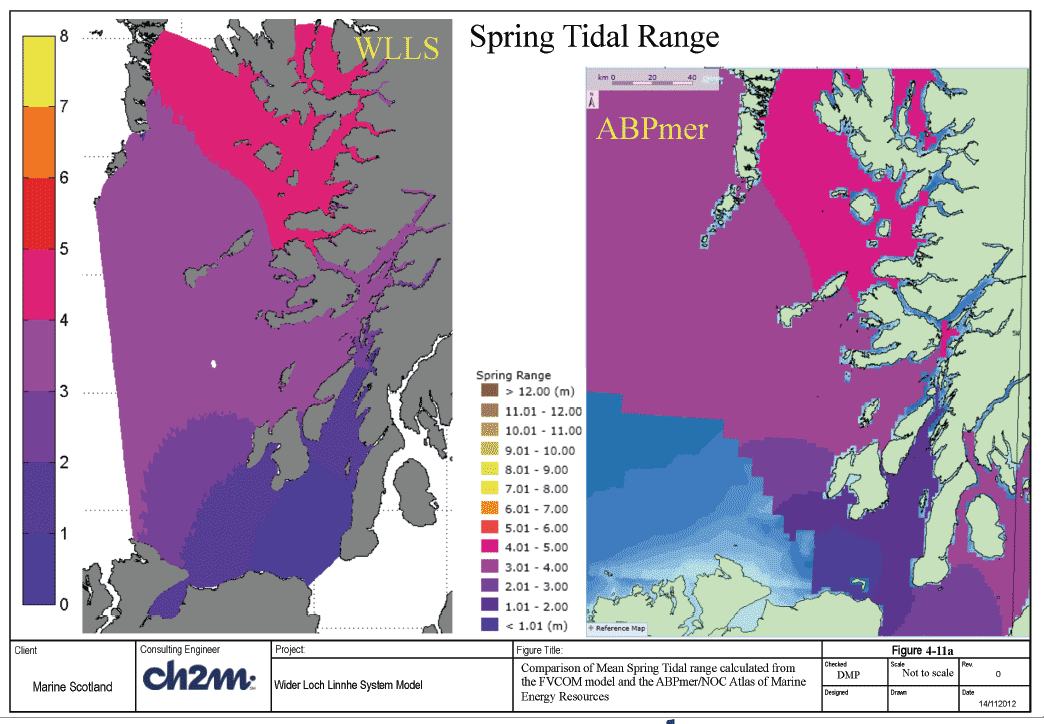
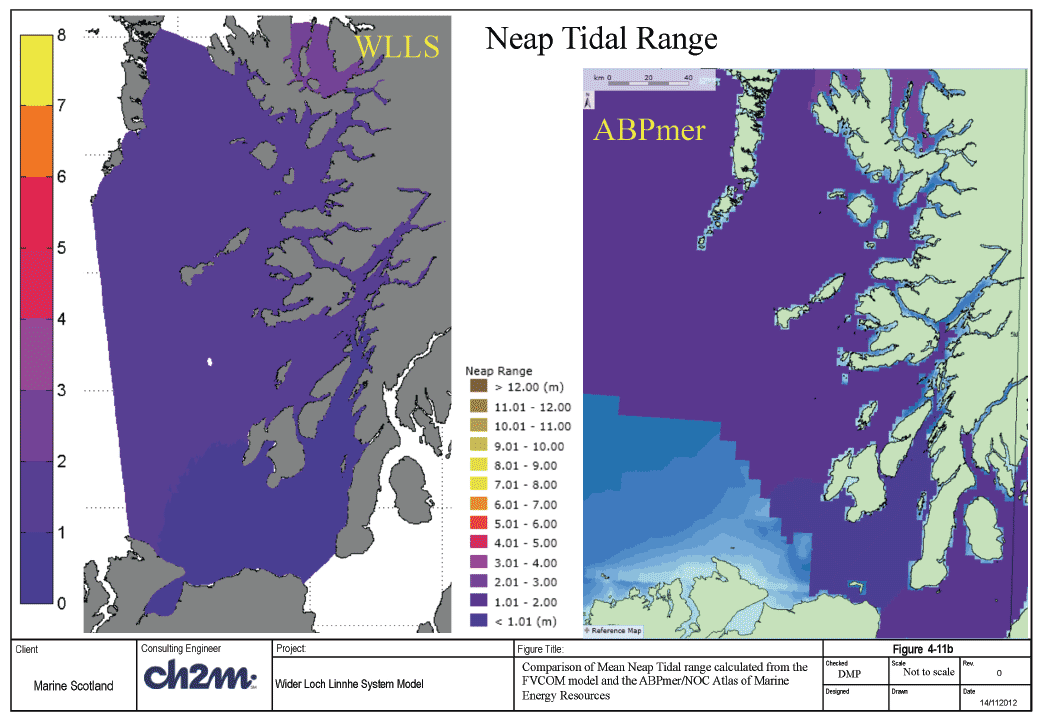
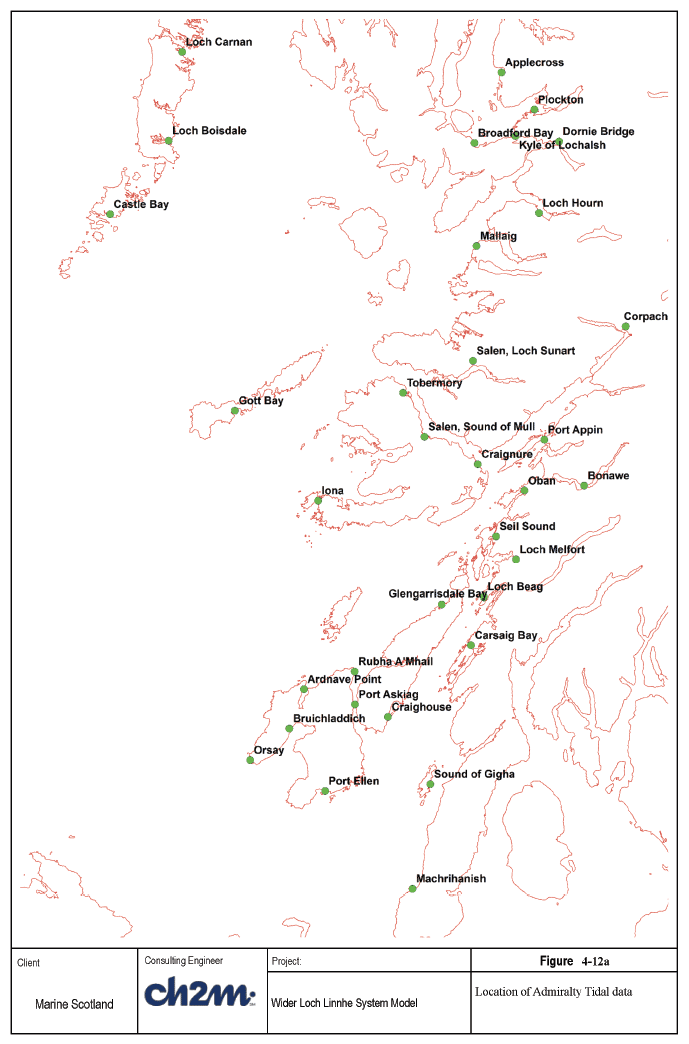
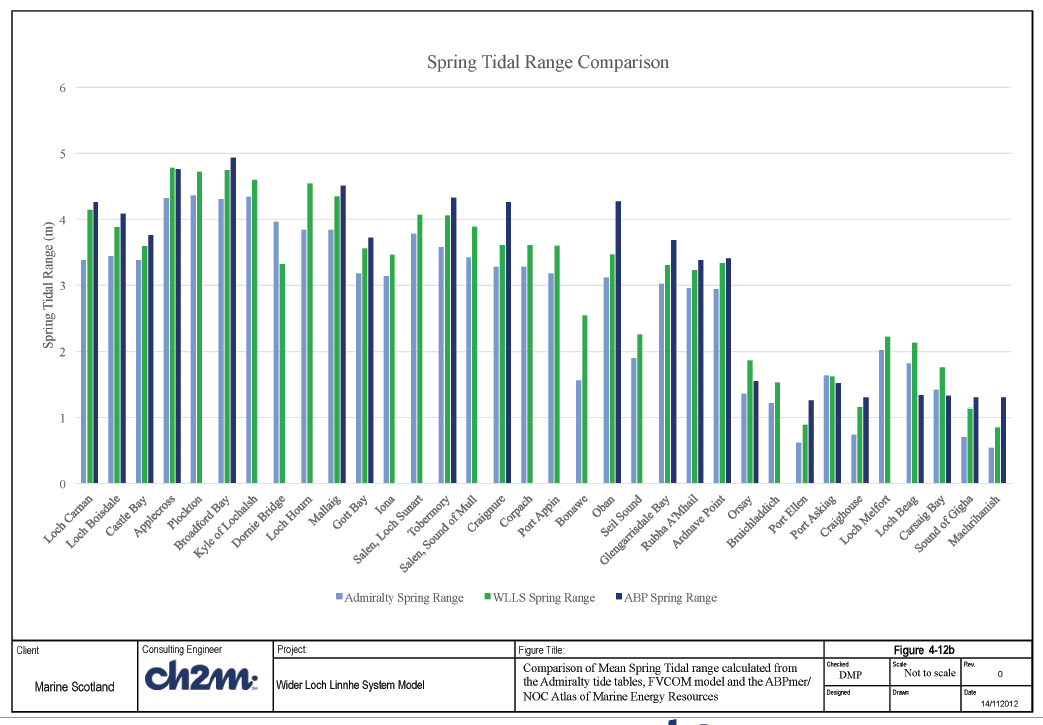
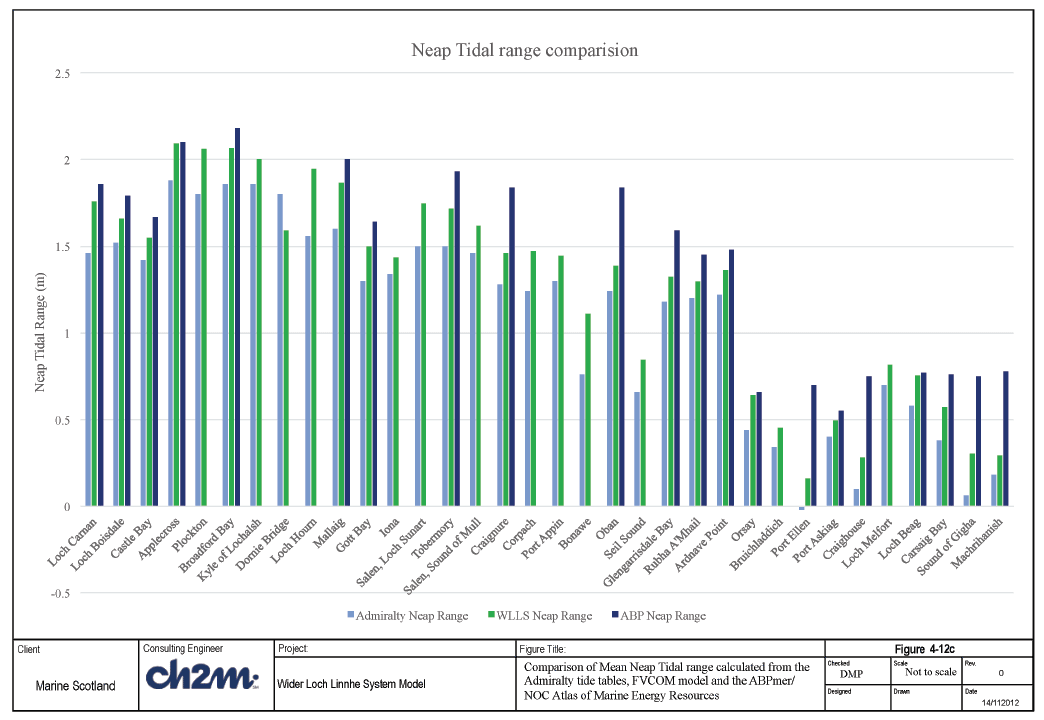
4.3.3.3 Mean Spring/Neap Currents
Mean peak current speeds have been calculated from a harmonic analysis of 60 days (01/January - 01/March) of depth averaged tidal velocities, from the WLLS climatology run. In line with the methodology used for the ABPmer / NOC Atlas, a mid-depth velocity was used for the calculations. The east and west components of velocity were analysed using T_TIDE to give the M 2 and S 2 amplitudes and phases. These were in turn analysed to give the semi-major axis amplitudes for each ellipse. The mean peak spring current was then computed as:
mean peak spring current = amplitude semi-major axis M 2 + amplitude semi-major axis S 2
The mean neap spring current was computed as:
mean peak neap current = amplitude semi-major axis M 2 - amplitude semi-major axis S 2
A map of the results for mean spring current is shown, along with the equivalent peak currents from the ABPmer / NOC Atlas of Marine Energy Resources, in Figure 4-13a. Corresponding plots for the mean neap current are shown in Figure 4-13b. The peak spring flow data from the ABPmer Atlas is taken from a higher resolution flexible mesh model which includes many of the Sounds and Lochs that are omitted from the regular grid model. The spatial variations in spring peak speeds are consistent between the two models, the peak speeds are seen to the northeast of Jura and through the North Channel of the Irish Sea. However the ABPmer model gives a slightly higher estimate of the peak flows. The comparison of the neap peak flows, using the lower resolution, regular grid ABPmer model shows good spatial agreement on the location of peak flows. Again the ABPmer results show higher peak flows.
4.3.3.4 Residual Currents
The residual surface currents from WLLS and the Scottish Shelf model are displayed in Figure 4-14 for February and August. In all cases the residual flow is to the north, which is in line with existing knowledge of the residual current in this area. The speed of the residual currents in the WLLS FVCOM model is greater than that from the Scottish Shelf model. For both the Scottish Shelf and the WLLS FVCOM model the residuals are stronger in August than February and location of the peak residual speeds are broadly the same in both models, i.e. through the passage of Tiree, the south Minch, to the north of Jura and south of Islay.
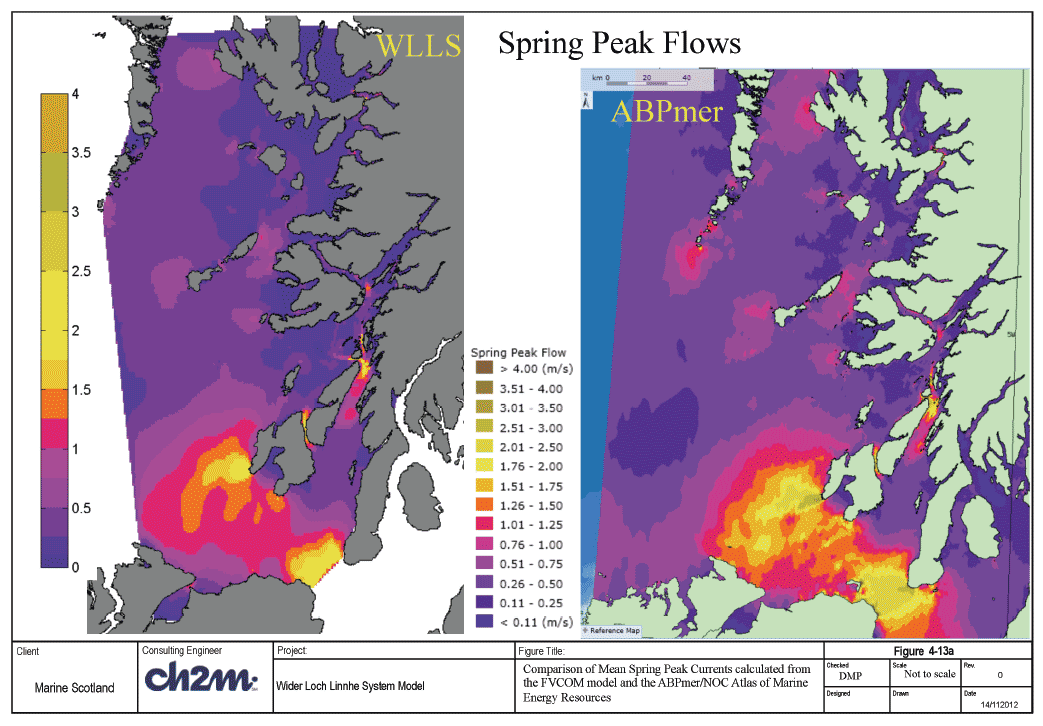
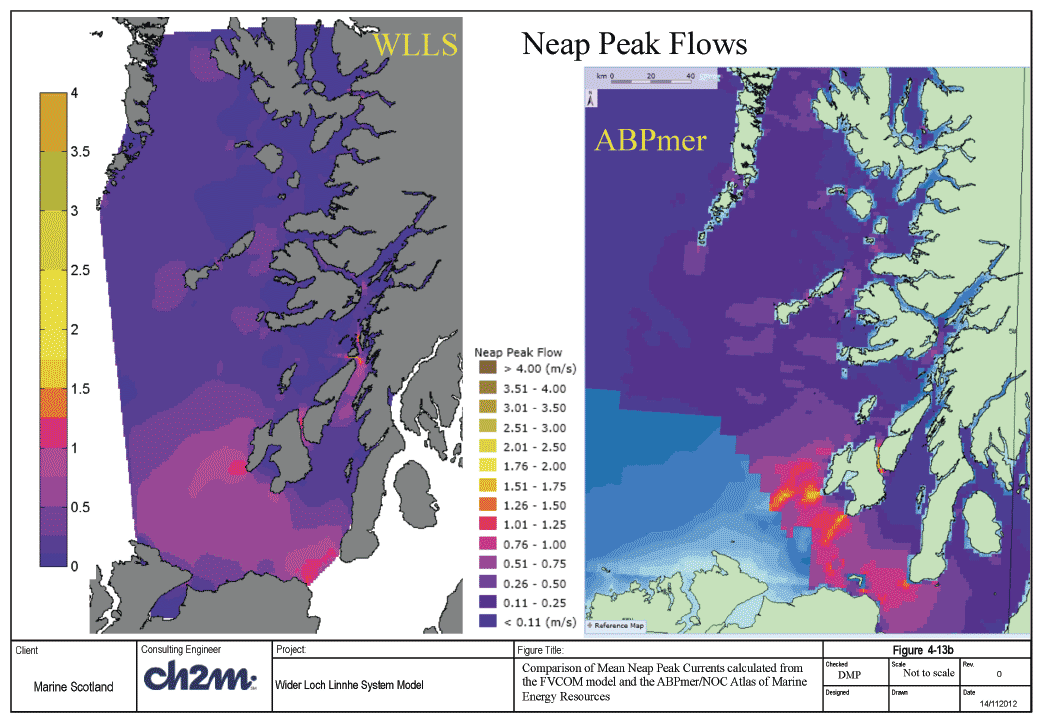
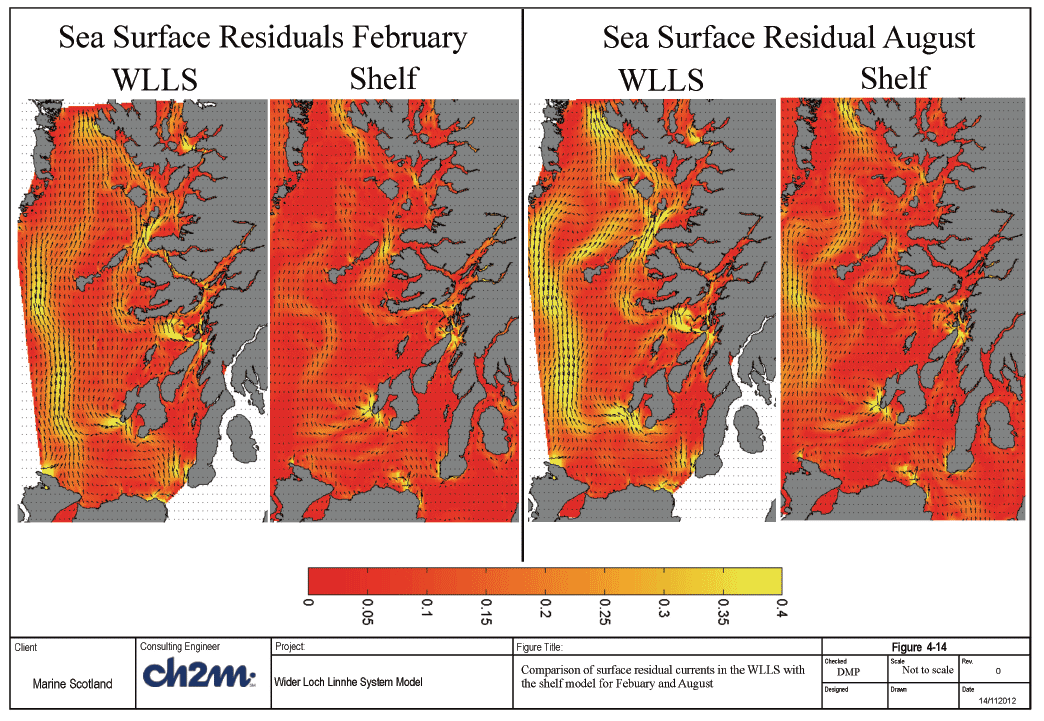
4.3.3.5 Seasonal Variations
Seasonal variations in sea surface temperature and salinity are shown in Figures 4-15a-b and 4-16a-b. Sea surface and bottom temperatures are at their lowest in January and highest in July, and warmer in the autumn than the spring as would be expected. The areas with higher sea bed temperature in July coincide with relatively shallow areas. The difference between sea surface and bottom temperature throughout the year is shown in Figure 4-15c. It gives an indication of the stratification of the water column. In autumn and winter, there is very little difference in temperature implying there is little or no stratification, while in spring and summer the surface temperature is slightly higher in Loch Linnhe and higher generally off shore. The temperature difference in Loch Sunart and Loch Etive is not as pronounced.
The salinity in the model is lower close to land both at the sea surface and bottom all year round, due to fresh water inputs to the system. The salinity at the surface in these areas is always lower. During the summer and autumn an incursion of high salinity Atlantic water can be seen north of Tiree and Col. As with the temperature difference plots the salinity difference plots give an indication of the water column stratification (Figure 4-16c). Note the pale green areas though the sound of Mull (A), around Jura (B) and Islay (C), Loch Sunart (D) and in the upper end of Loch Etive (E) in both Figure 4-15c and 4-16c which indicate low stratification potential. The reason for the low potential varies at the different locations. The high flows through the Sound of Mull and around Jura and Islay mean the water column is likely to be well mixed in those areas. However the low stratification potential in the Lochs is more to do with the low river flows in Loch Sunart and into the top end of Loch Etive within the model.
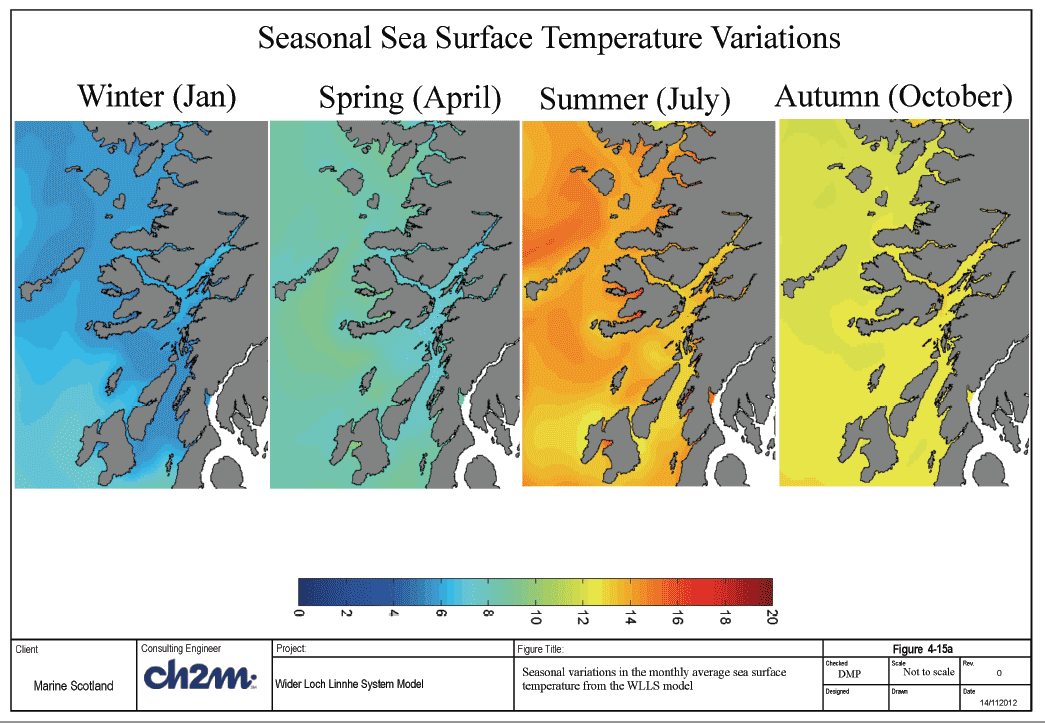
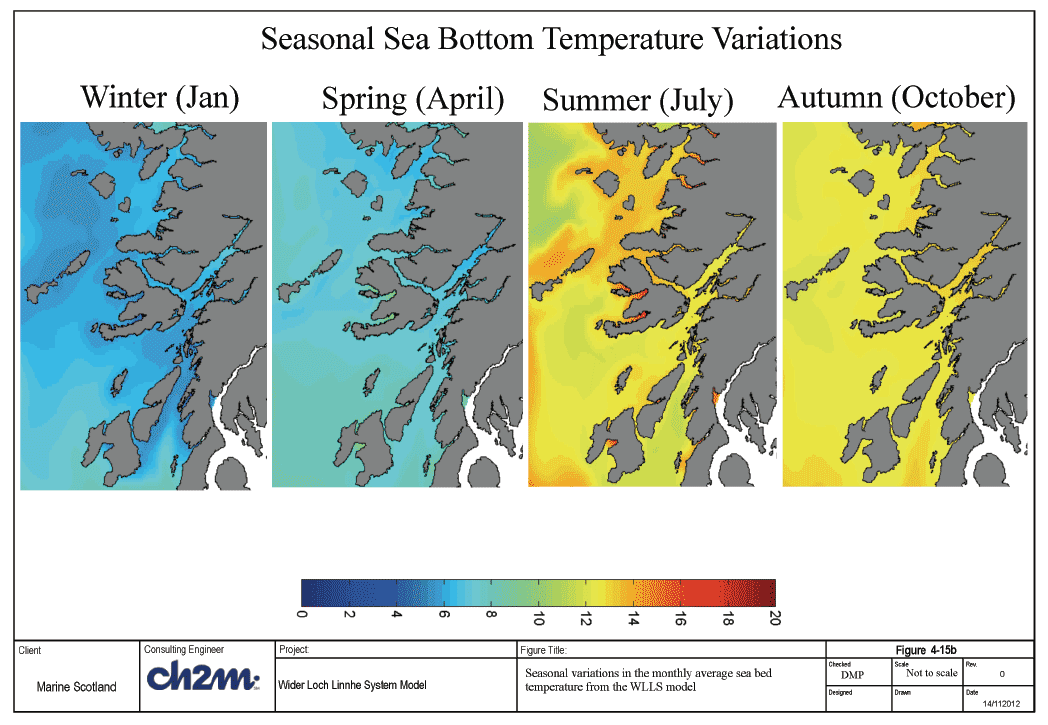
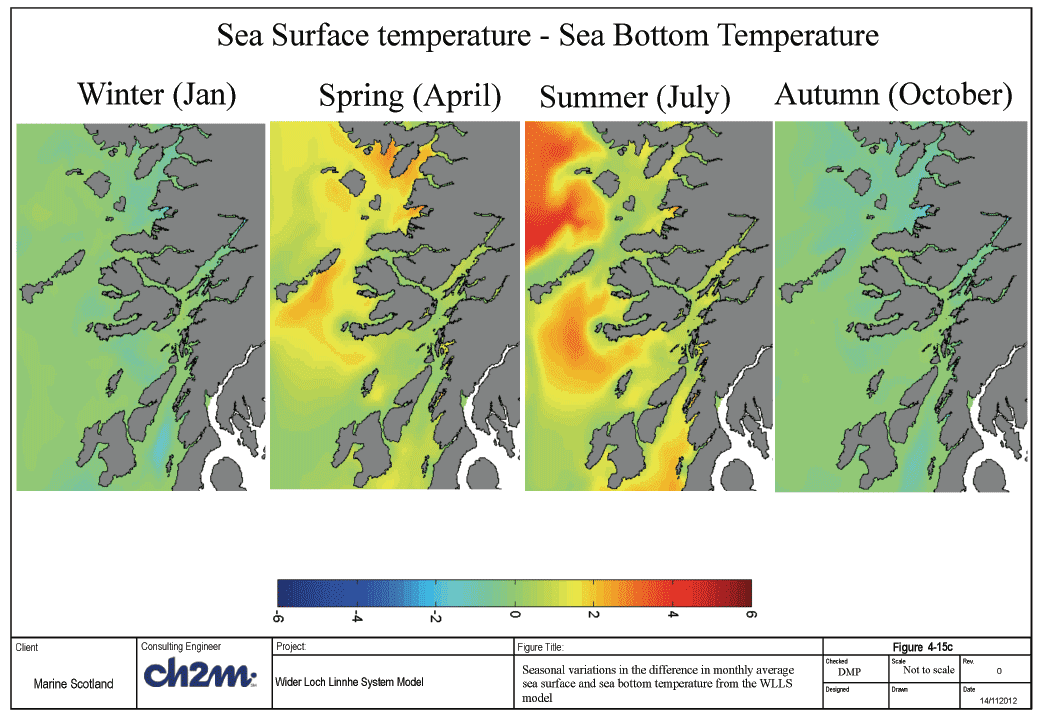
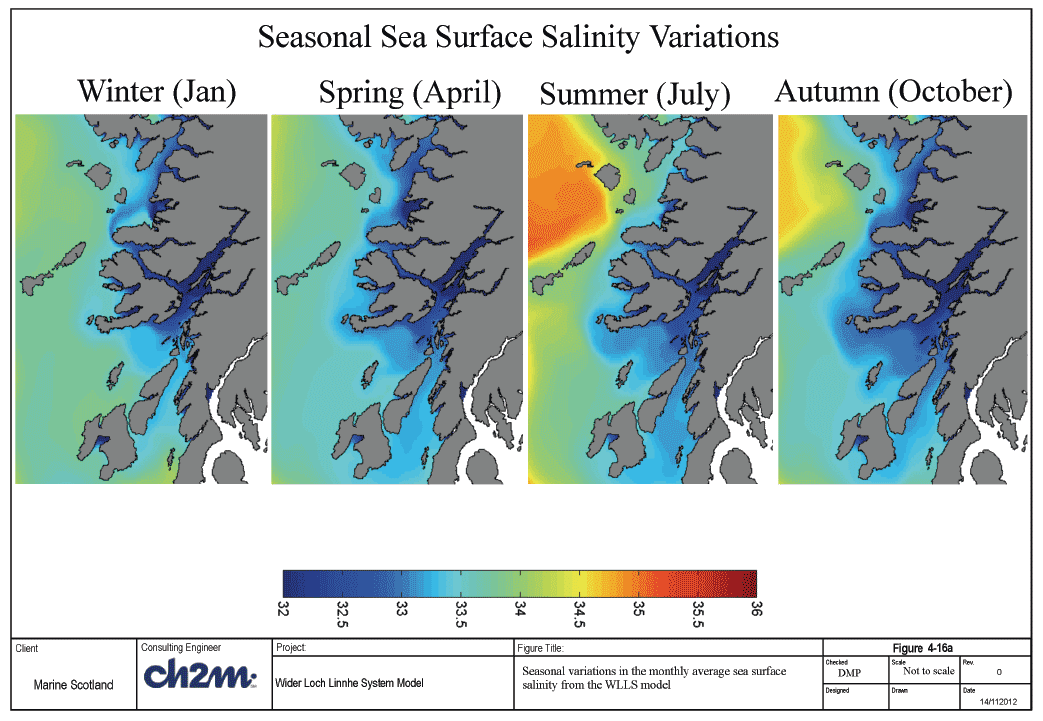
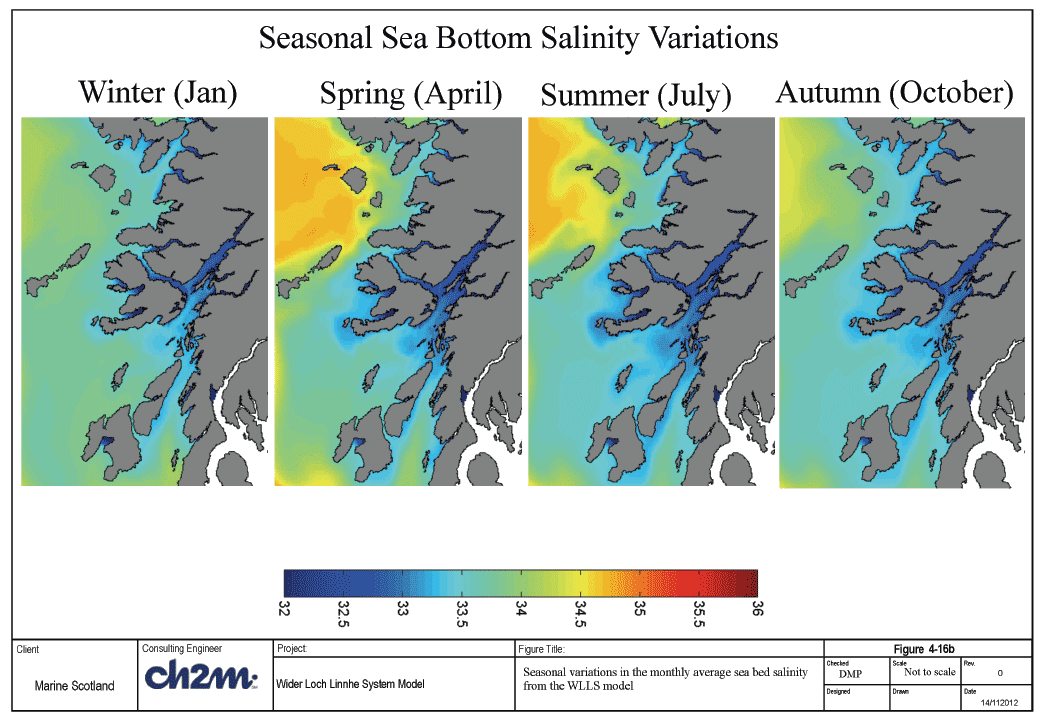
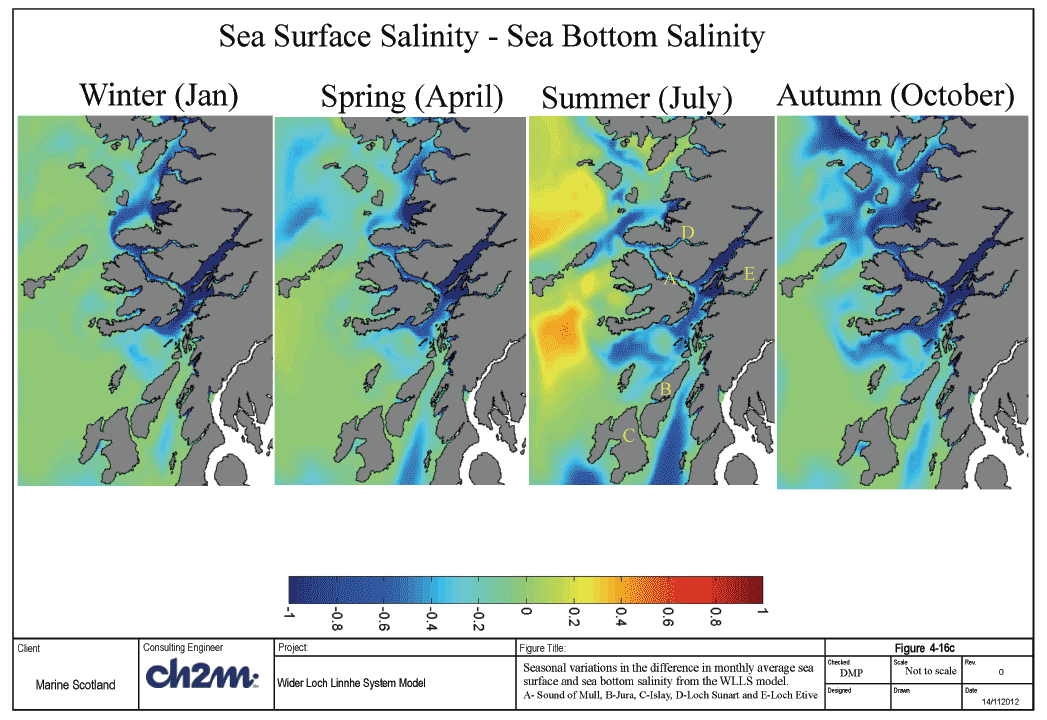
4.4 Discussion
The Wider Loch Linnhe system contains a number of fjordic sea lochs characterised by deep, often stratified, semi enclosed basins separated from the sea by a shallow sill at the mouth. Circulation in these sea lochs is controlled by freshwater inflow and meteorological forcing. Previous research has revealed a number of mechanisms for deep water mixing and renewal within these sea lochs landward of the sills including deep water inflows and internal tides. Evidence of deep water inflows of denser saline water from the sea in Upper Loch Linnhe, Loch Sunart and Loch Etive is presented in Allen and Simpson (1998a and 2002), Austin and Inall (2002) and Gillibrand et al. (1995). Allen and Simpson (1998b) also identified an internal tide in Upper Loch Linnhe, a feature that persisted over the 7 months of measurements.
The occurrence of deep water inflows is controlled by freshwater inputs, tidal range and wind conditions. Low freshwater input and high tidal range combined with strong seaward winds increase the likelihood of inflows, while high freshwater discharge rates, low tidal range and landward winds have the opposite effect (Allen and Simpson, 1998a, Gillibrand et al. (1995). The seaward winds move low salinity water away from the sill and enhance estuarine circulation in the lower loch, increasing the density of the deeper water over the sill (Gillibrand et al., 1995). Inflows are likely to occur when the density at the sill is greater than that of the deep water in the upper loch. They are characterised by an increase in the near bed velocity compared to the depth averaged velocity, an increase in the deep water salinity and at times rapid changes in temperature. A rapid change in temperature is not always seen, but only when the temperature of the inflowing dense water differs from the deep water temperature.
To test whether the model is capable of replicating these deep water inflows a number of parameters ( i.e. salinity, temperature, current speeds and σ T (ρ(S, T)-1000kg/m 3 - i.e. a measure of density of sea water at a given temperature)) were extracted on the sill and in the upper loch near the bed of Loch Linnhe, Loch Sunart and Loch Etive (Figure 4-17).
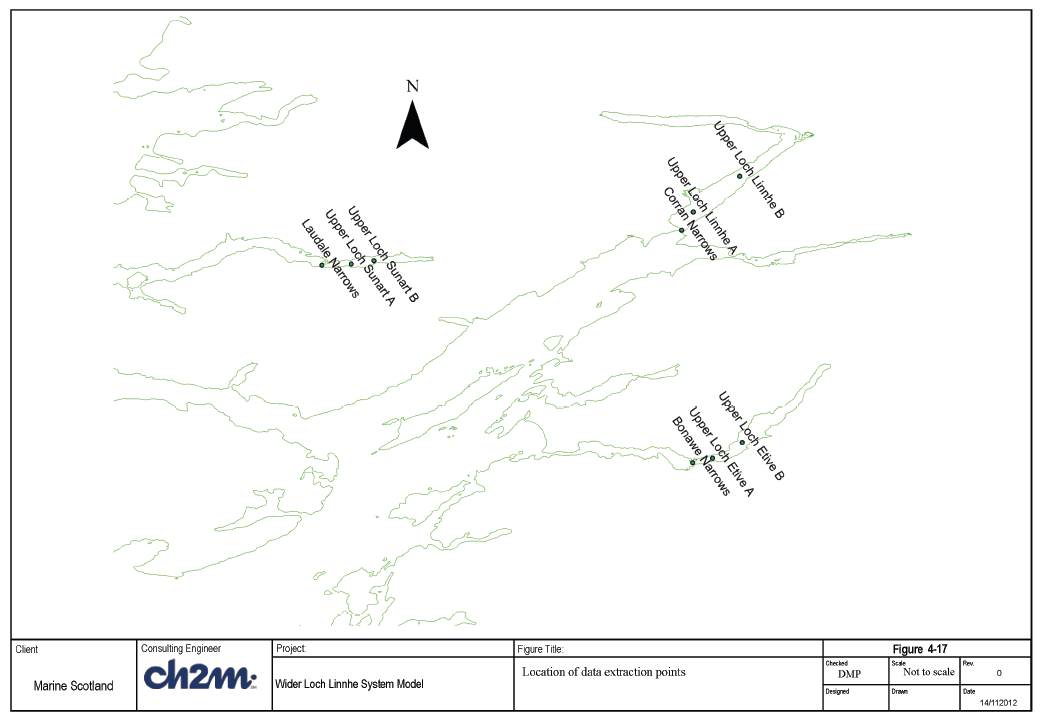
4.4.1 Loch Linnhe
Data for May to October at Loch Linnhe is presented in Figure 4-18. Panel a shows the difference in the near bed σ T on the sill to point A and B in the Upper Loch, positive values indicate that the density at the sill is greater than the deep water in the Loch and there is potential for deep water inflows. Panel b shows the depth average current speed minus the near bed current speed at points A and B. Negative values indicate that the flow at the bed is greater than the average and is an indication of deep water inflows of higher density water. Panel c shows the σ T variations near the bed at points A and B and panel d shows the river discharge into the upper loch. These plots reveal the influence of both river discharge to reduce the density in the upper loch through vertical mixing and of inflows of higher density water over the sill at Corran Narrows. The drop in σ T in late May/early June and towards the end of September occur several days after high river flows into the upper loch, while the increase in σ T during June occurs when the σ T difference between the narrows and the deep water in the upper loch is at its highest. This coincides with a time when densities in the upper loch have been reduced by freshwater inputs increasing the potential for inflows over the sill. Despite the increased potential in inflows seen in October, the σ T of the deep water in the upper loch does not increase at the rate seen in June, most likely due to the sustained input of fresh water during that time.
Allen and Simpson (1998) describe deep water inflows as pulses of denser water being advected into the loch on successive tides over a period of several days. By zooming in to June the tidal signal and the gradual increase in σ T in the deep water of the upper loch as semi diurnal pluses can be clearly seen (Figure 4-19). In October the increase in σ T is tempered by the sustained river flow, with any increases in σ T occurring during periods of relatively low river flow (Figure 4-20).
4.4.2 Loch Sunart
The upper basin of Loch Sunart is subject to much lower river discharge than upper Loch Linnhe and therefore has a higher potential for deep water inflows. A previous study by Gillibrand et al. (1995), found that deep water inflows occurred frequently, at least once a month. The results at Loch Sunart are shown in Figure 4-21 for May to October 2011 and, zoomed into July and August in Figure 4-22, the parameters presented are the same as those in Figure 4-18 with the addition of water level at the Laudale Narrows. The σ T changes seen in Loch Sunart are much cleaner than those seen in Loch Linnhe especially at Point A. The relative σ T at the narrow and deep water also shows a more defined signal relating to increases in σ T and relative near bed current speeds. The increased clarity of the signals is likely to be due to the lower fresh water input into the upper loch. The relationship between freshwater input, reducing density and inflow of higher density water over the sill is clearly seen. Another relationship is apparent in the data, that of tidal range and inflow. Many of the inflow events, characterised by an increase in near bed density coincide with spring tides, supporting the assertion in the literature that increased tidal range increases the potential for deep water inflows (Allen and Simpson, 1998a and 2002, Austin and Inall, 2002 and Gillibrand et al., 1995).
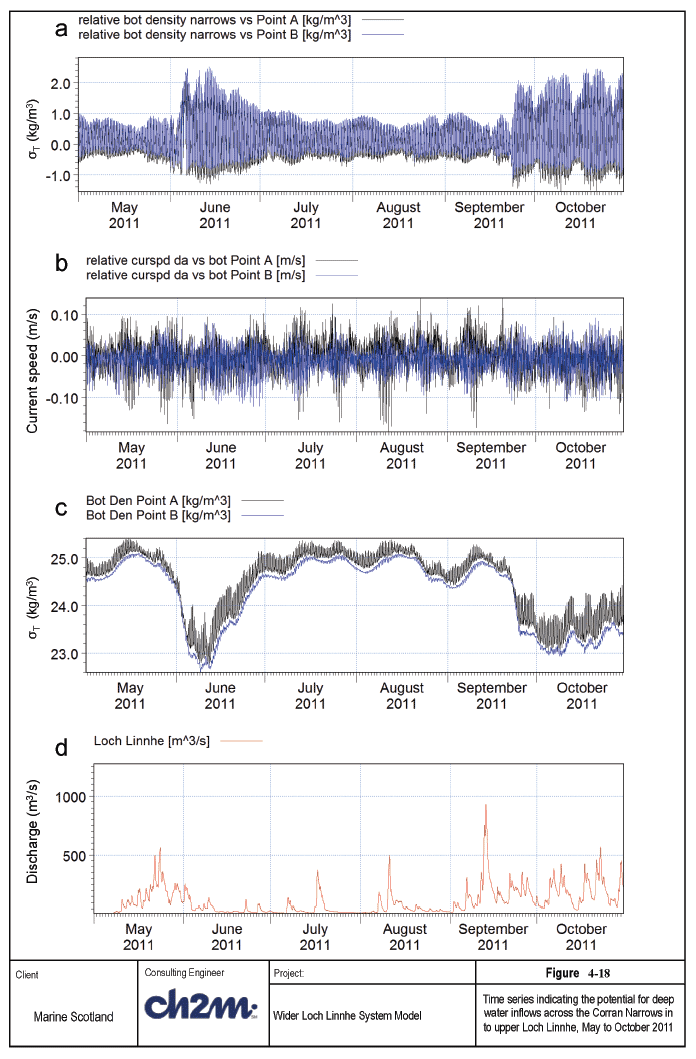
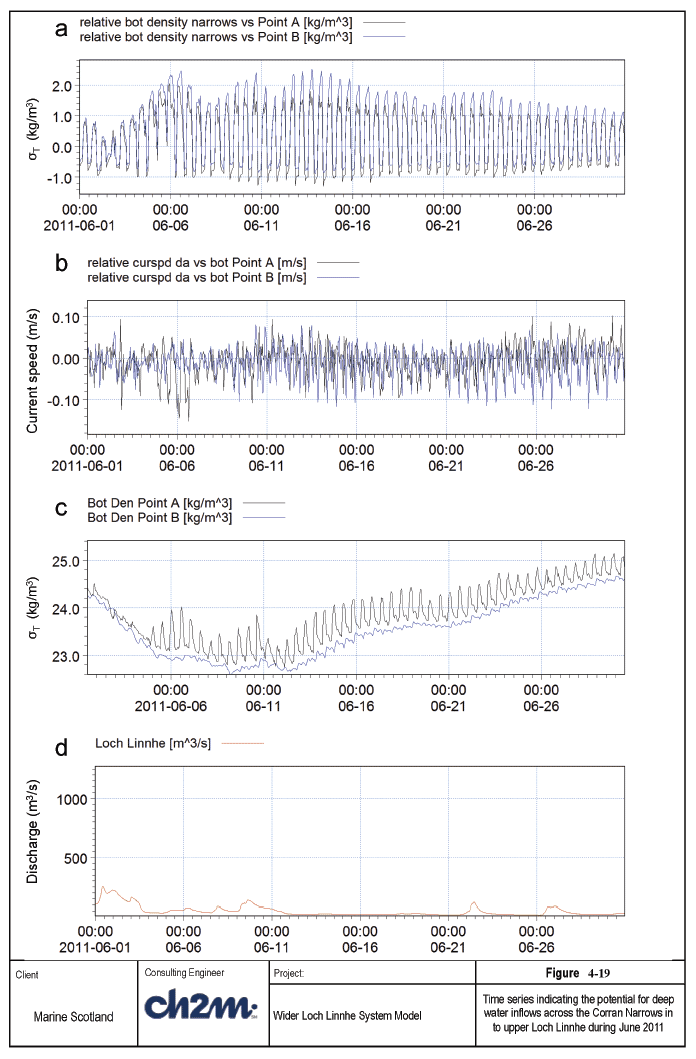
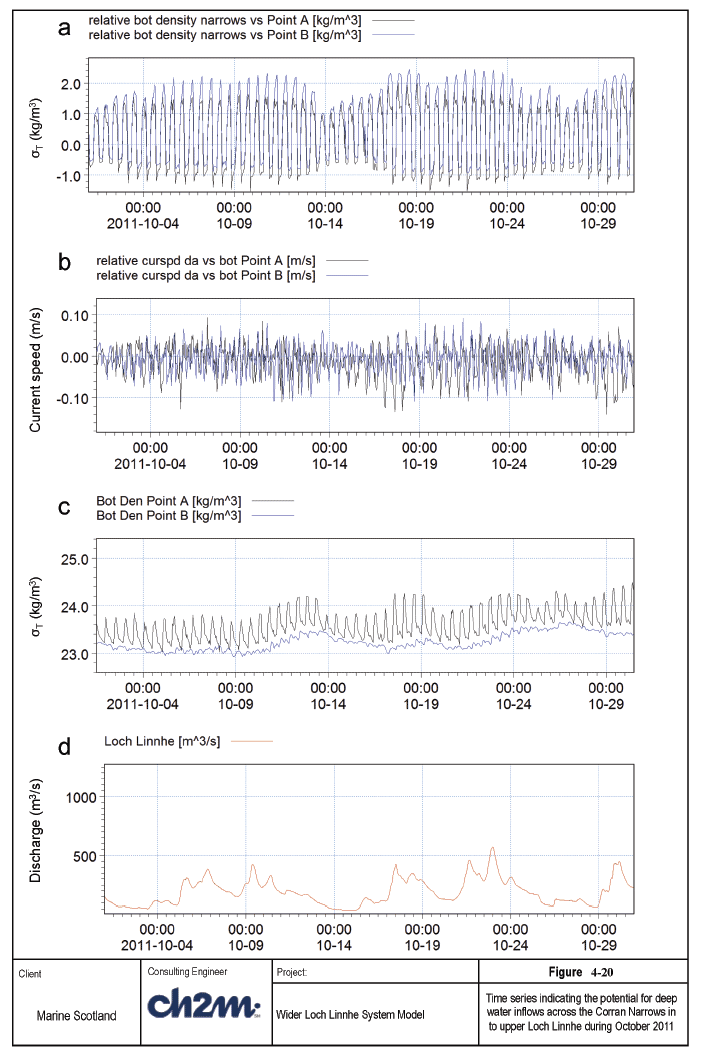
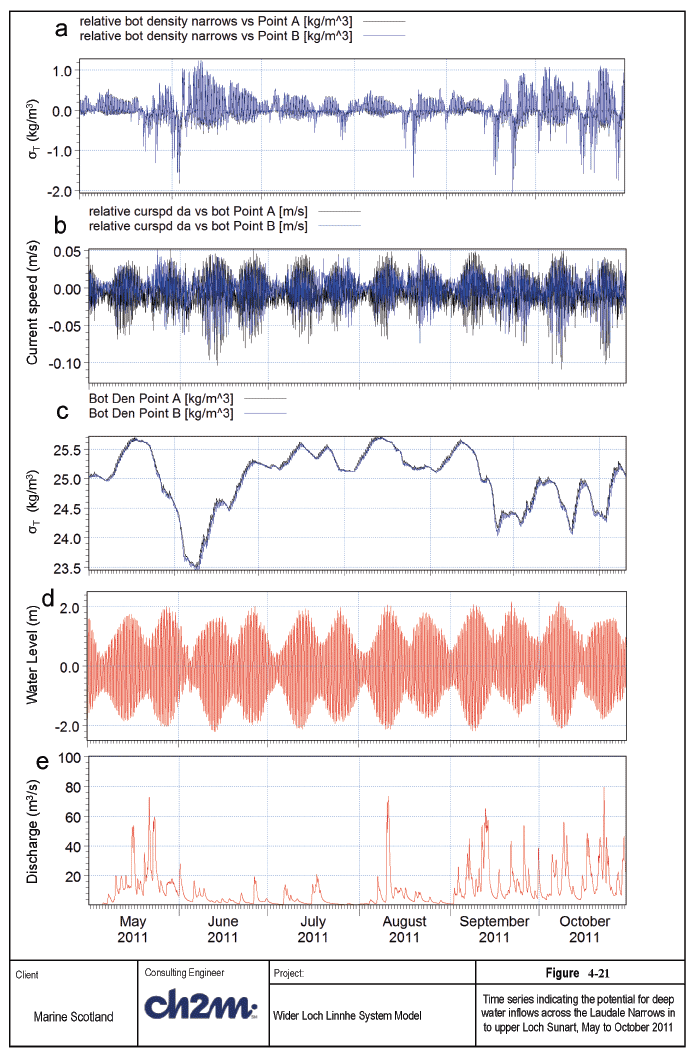
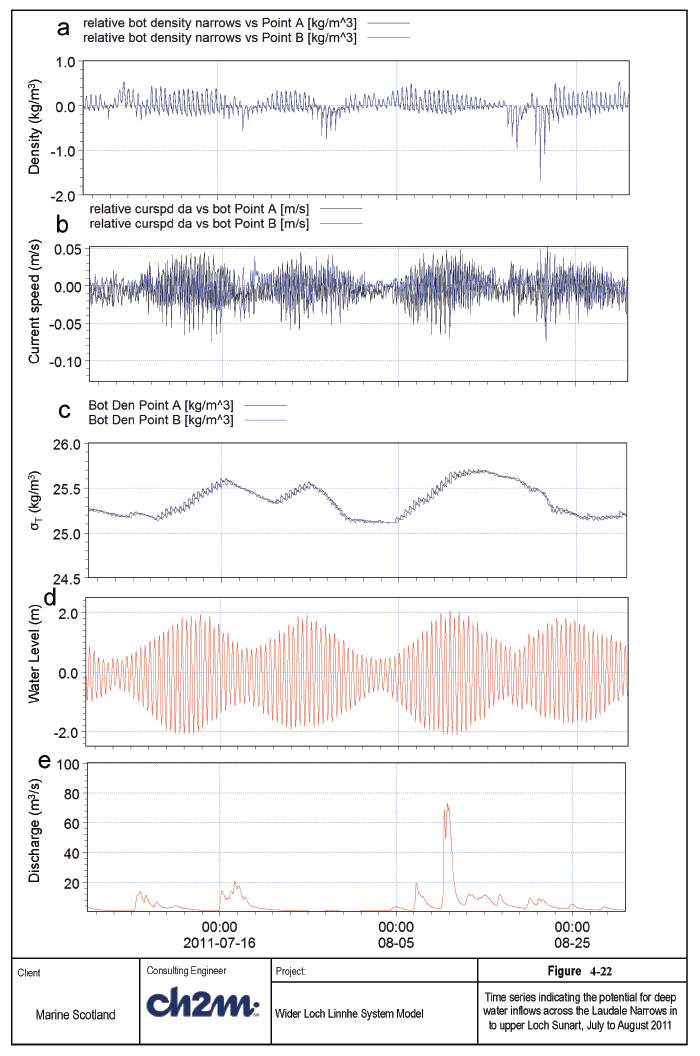
4.4.3 Loch Etive
Analysis of the Loch Etive results revealed an error in the way the rivers have been applied to the model within this loch. All the rivers flowing into Loch Etive were provided as a single output at the mouth of the loch in the G2G data provided by CEH. Therefore it was necessary to redistribute the flows using the catchment area ratios shown in Figure 4-23 from the river specified at the mouth (324) to the individual rivers within the loch (665-668). However, due to a mix up in the river numbers provided by CEH, flows from the wrong river (326) were redistributed to rivers 665 to 668. The mean and maximum discharges of the two rivers are also shown in Figure 4-23. The total freshwater input to the model was correct but the distribution in Loch Etive was not. This means the results for temperature and salinity within Loch Etive are not valid and the results in this region are not presented in terms of the potential for deep water inflows.
A sensitivity test was carried out for May 2011 with the correct river redistributed. Time series of water level and depth averaged current speed, and surface, mid and near bed temperature and salinity were extracted at a number of locations around the mouth of Loch Etive from both the May calibration run and the sensitivity run with the corrected river distribution. The RMS (root mean square) difference and bias between the two runs was calculated. The RMS difference and bias for water level and current speed was less than 0.006m and 0.07m/s respectively at all locations. The temperature and salinity RMS difference and bias are presented in Figure 4-24 and 4-25 respectively along with the extraction locations. The RMS difference in temperature is very small less than 0.15 degrees Celsius at all locations and depths, the bias is even smaller, not exceeding 0.06 degrees Celsius. There is no obvious pattern in the data, i.e. the RMS difference is not greater close to the mouth of Loch Etive.
The salinity comparisons however, show clearly the influence of the distribution of the rivers. The maximum RMS difference and bias are seen at location D (2.4 and 1.7 psu) and E (1.3 and 1 psu) in the surface waters. This can be expected due to the increase in the distance the fresh water must travel before reaching these point when redistributed further up the Loch. In the mid bed level measurements the RMS difference and bias do not exceed 0.5 and 0.4 psu, and in the deep water the difference and bias do not exceed 0.1 and 0.05 psu. Away from the mouth of Loch Etive the influence is small even at the surface with RMS difference and bias less than 0.3 and 0.2 psu respectively at any level or location. A number of CTD comparisons with measured data and the calibration and sensitivity run are shown in Figure 4-26a-e, these plots support the argument that the change in temperature is minimal and the change in salinity is most significant near to the Loch mouth at the surface.
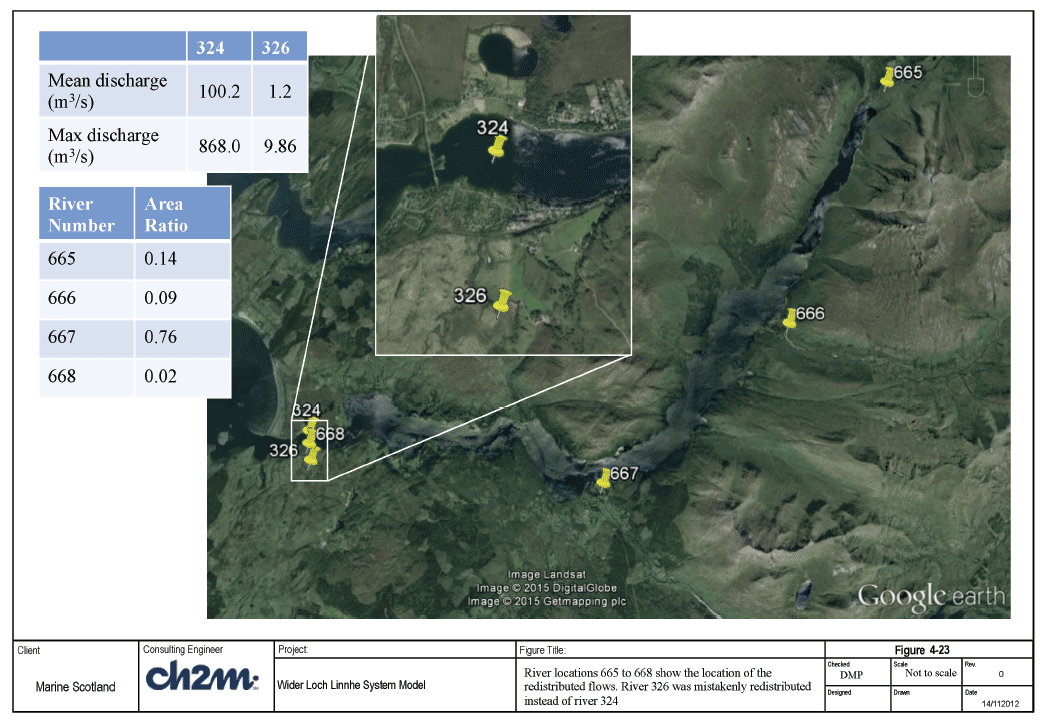
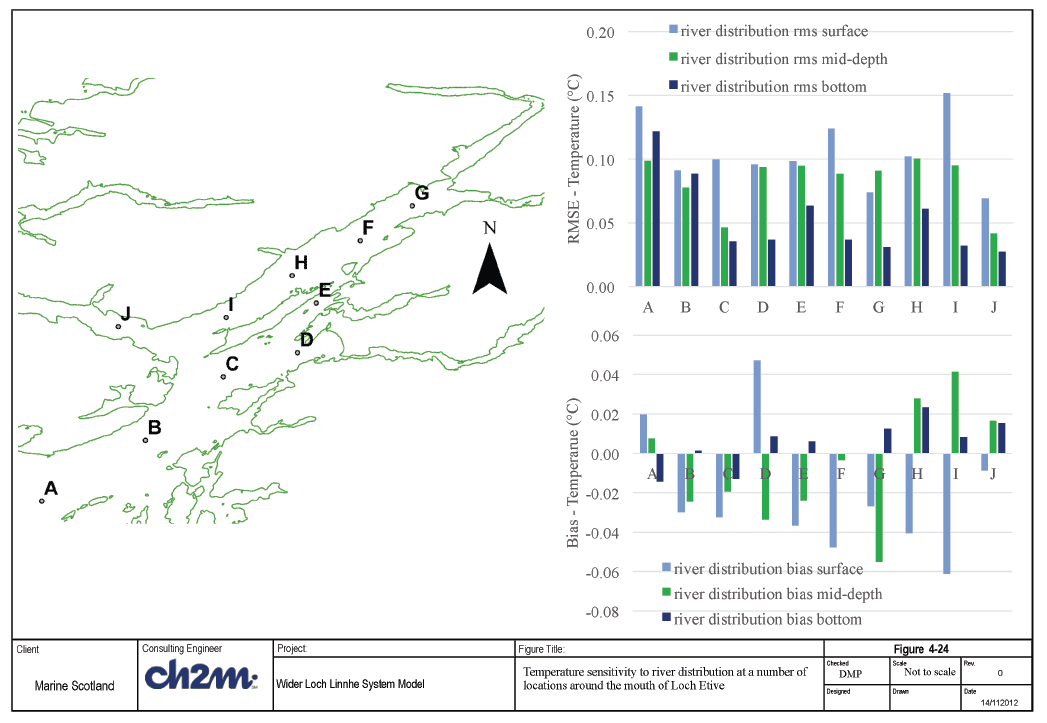
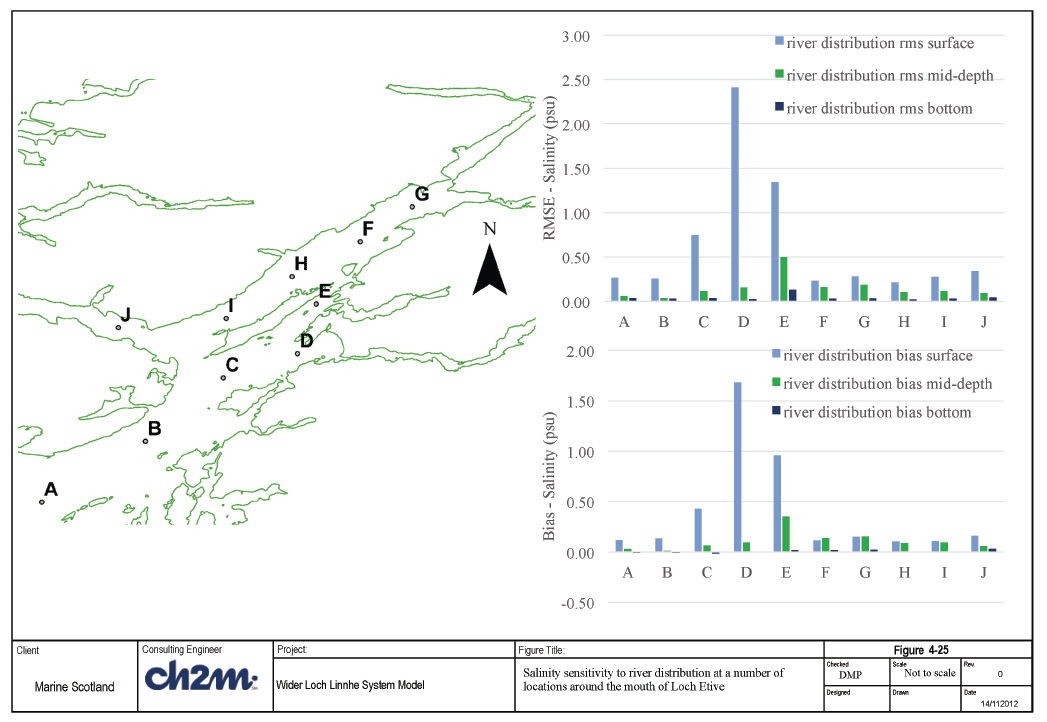
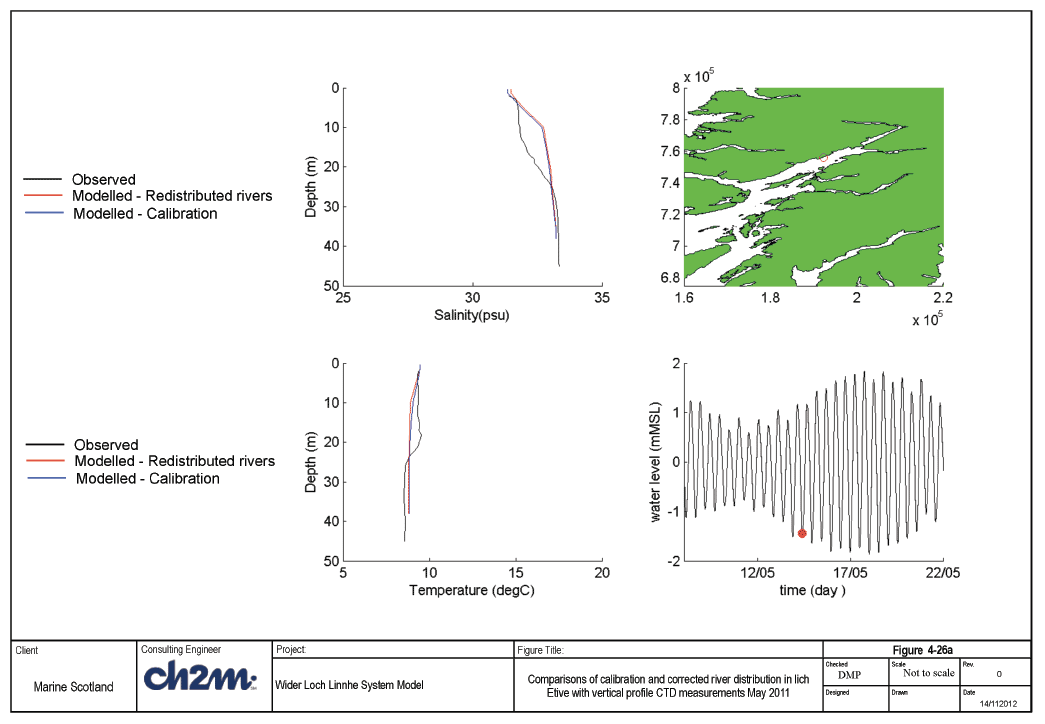
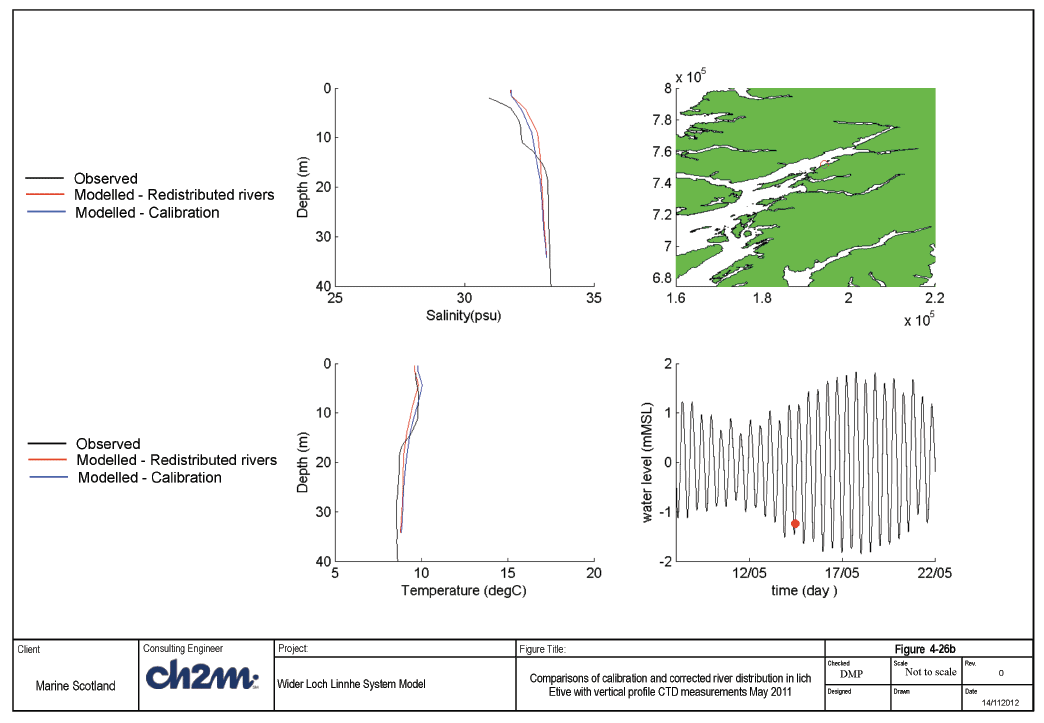
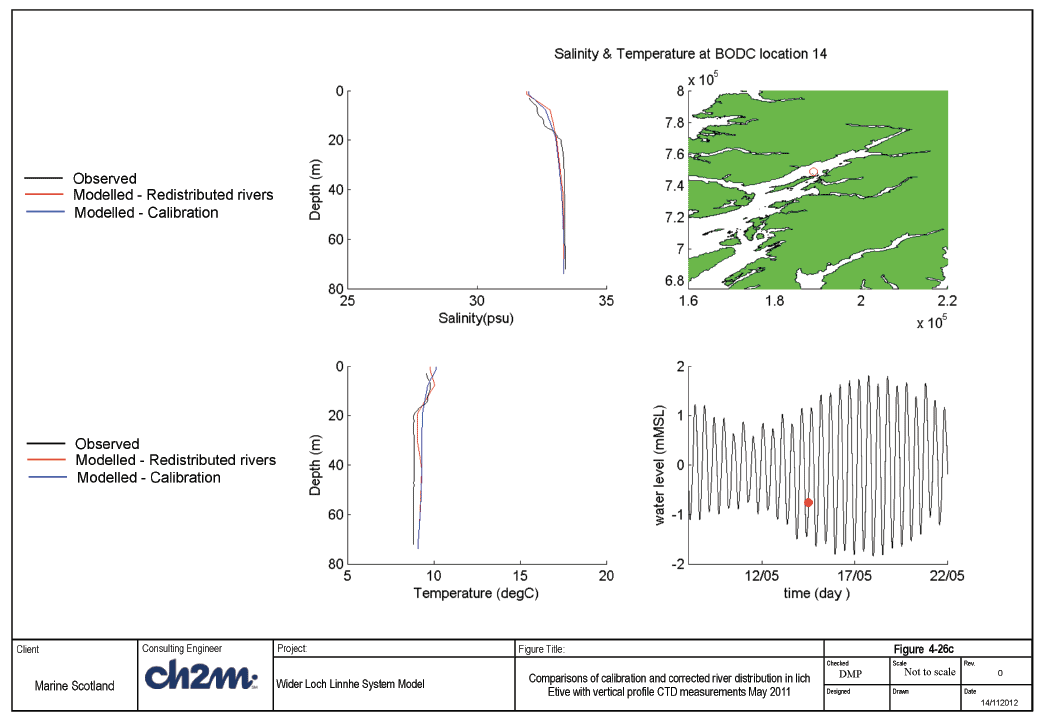
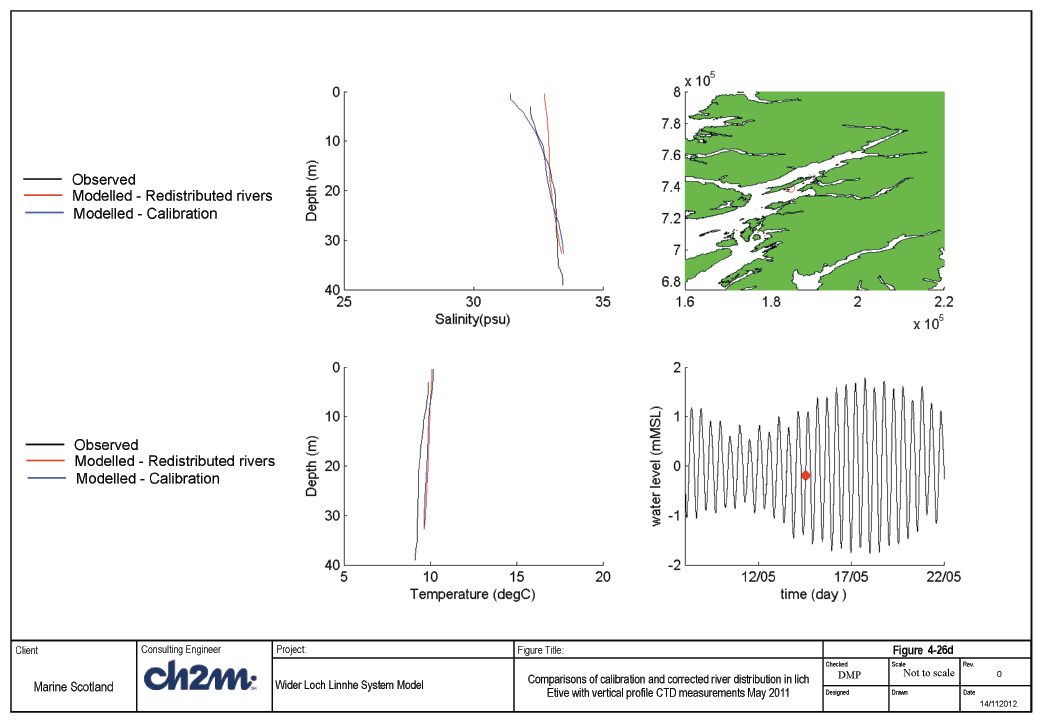
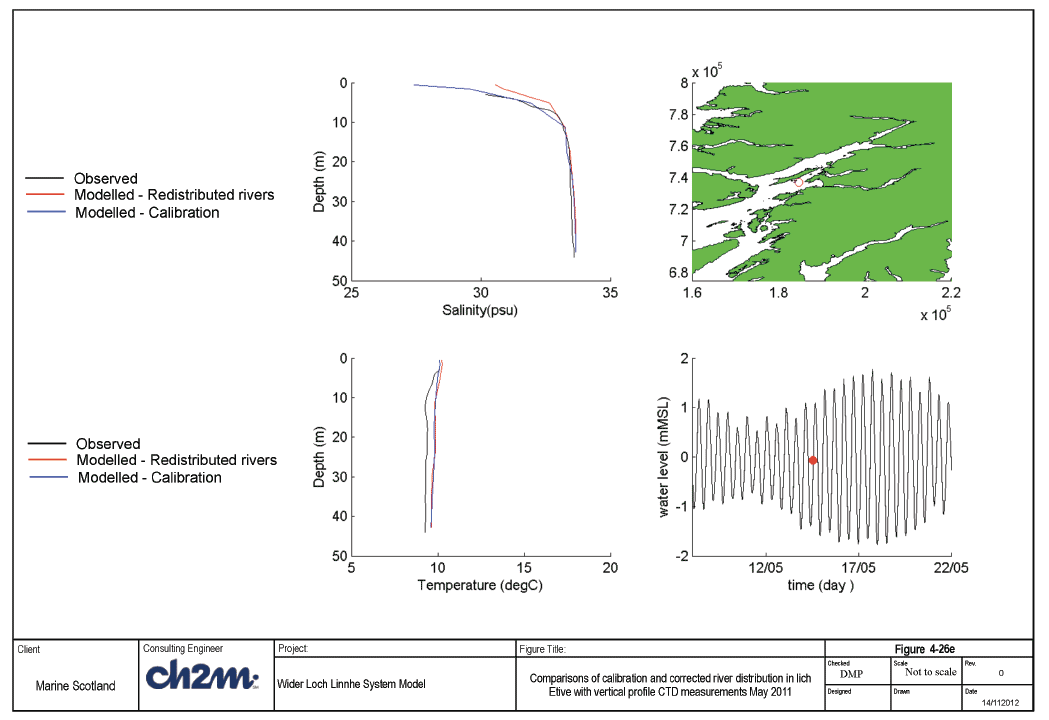
Contact
There is a problem
Thanks for your feedback